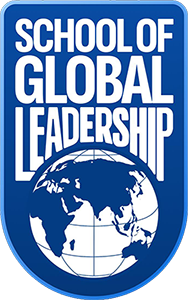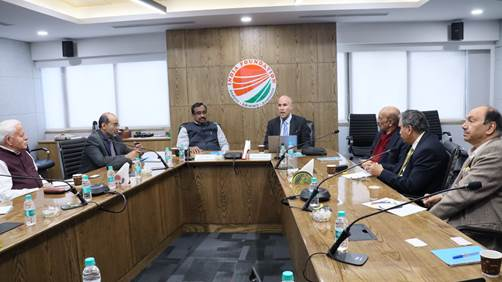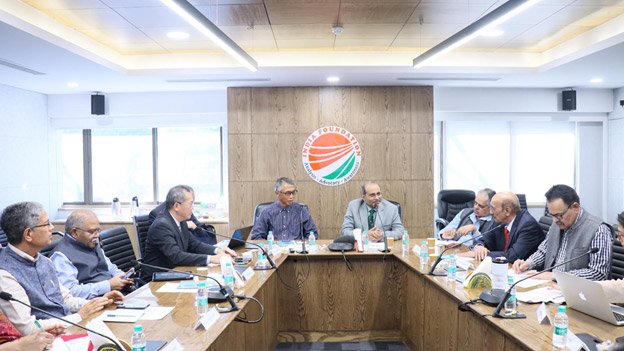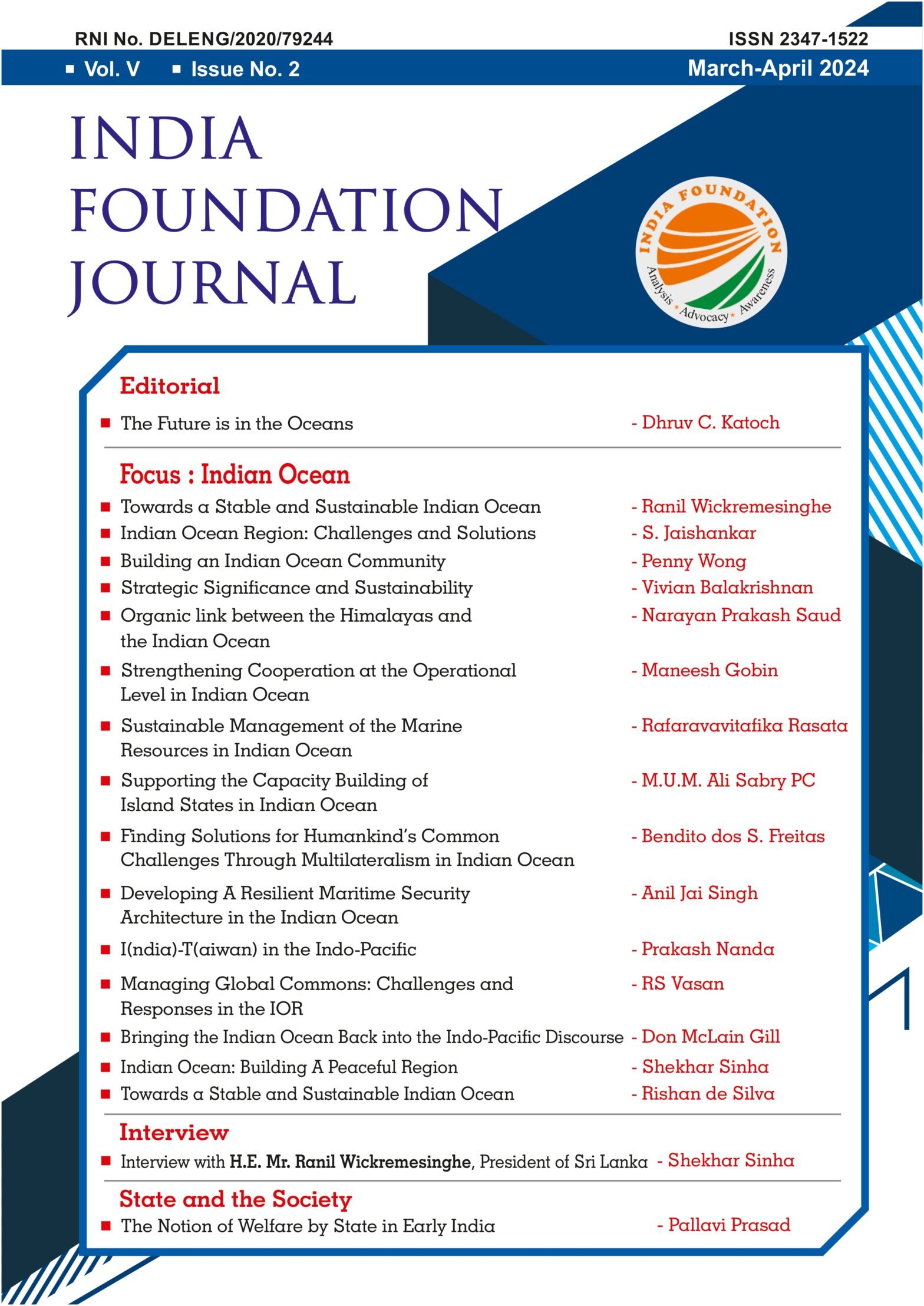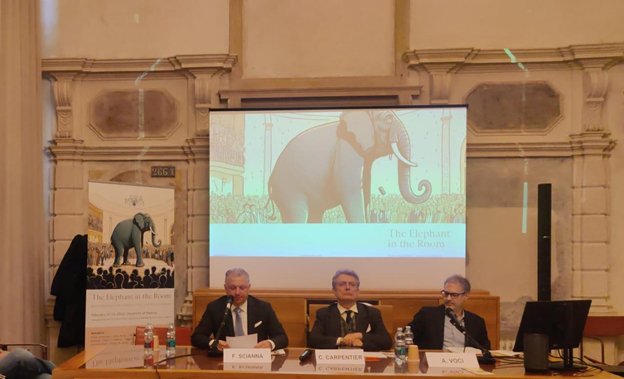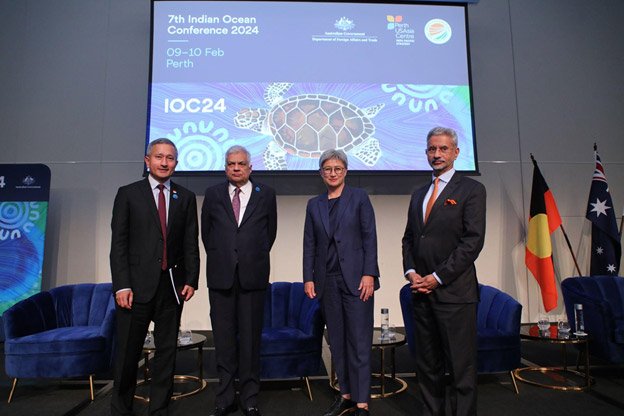India Foundation hosted the 94th India Foundation Dialogue on 02 April, 2024 in New Delhi. Vice Admiral G Ashok Kumar, National Maritime Security Coordinator, National Security Council Secretariat, Government of India, delivered his address on “India’s Maritime Security – Challenges and Prospects”. The session was chaired by Capt Alok Bansal, Director, India Foundation.
नेपाल–भारत अंतर्राष्ट्रीय संस्कृत सम्मेलन – २०२४
काष्ठमण्डप, नेपाल
विक्रमसं. २०८० चैत्र १४ – १६ तदनुसार २७–२९ मार्च २०२४
सम्मेलन-प्रतिवेदन
पृष्ठभूमि
वि. सं. २०८० चैत्र १४ – १६ तदनुसार २७–२९ मार्च २०२४ को, नेपाल के संस्कृत विद्वानों की सक्रिय उपस्थिति में पार्क विलेज रिसोर्ट, बुढानीलकण्ठ, काठमांडू, नेपाल में तीन दिवसीय नेपाल–भारत अंतर्राष्ट्रीय संस्कृत सम्मेलन आयोजित किया गया था । नेपाल–भारत संस्कृत सम्मेलन का आयोजन नीति अनुसन्धान प्रतिष्ठान नेपाल (नेनाप), इंडिया फाउंडेशन, दिल्ली और केन्द्रीय संस्कृत विश्वविद्यालय, दिल्ली द्वारा किया गया था। सम्मेलन को तीन दिनों में क्रमशः तीन मुख्य विषयों, उद्घाटन सत्र, चर्चा सत्र और समापन सत्र में विभाजित किया गया था। इस संक्षिप्त प्रतिवेदन में अत्यंत भव्य, सभ्य और गरिमामय तीन दिवसीय संस्कृत सम्मेलन के संबंध में एक संक्षिप्त सर्वेक्षण और वर्णनात्मक परिचय प्रस्तुत किया गया है।
अंतर्राष्ट्रीय नेपाल–भारत संस्कृत सम्मेलन का उद्घाटन सत्र
सम्मेलन का पहला दिन वि.सं. १४ चैत्र २०८० तदनुसार २६ मार्च २०२४ को बुढानीलकण्ठ, काठमांडू में आयोजित संस्कृत सम्मेलन का उद्घाटन समारोह संपन्न हुआ । समारोह के मंच पर नीति अनुसन्धान प्रतिष्ठान, नेपाल (नेनाप) के कार्यकारी निदेशक डॉ. श्री केशवराज पन्थी जी उपस्थित थे, जबकि नेपाल सरकार के ऊर्जा, जलस्रोत और सिंचाई मंत्री माननीय श्री शक्ति बहादुर बस्नेत मुख्य अतिथि के रूप में उपस्थित थे। इसी प्रकार विशिष्ट अतिथियों एवं वक्ताओं में कुलपति प्रो. श्रीनिवास वरखेड़ी (केंद्रीय संस्कृत विश्वविद्यालय, दिल्ली), कुलपति प्रो. यादव प्रकाश लामिछाने (नेपाल संस्कृत विश्वविद्यालय) प्रो. शशिप्रभा कुमार (अध्यक्ष, भारतीय उच्च अध्ययन संस्थान, शिमला) वक्ता श्री दिनेश कामत (अखिल भारतीय संगठन मंत्री, संस्कृत भारती), प्रो. काशीनाथ न्यौपाने (चेयर प्रोफेसर, केन्द्रीय संस्कृत विश्वविद्यालय, दिल्ली) अतिथि के रूप में मञ्चासीन रहे।
आयोजक संस्थाओं की ओर से डा. दीपक कुमार अधिकारी, निदेशक, नीति अनुसन्धान प्रतिष्ठान नेपाल (नेनाप) ने सभी का गर्मजोशी से स्वागत किया । उन्होंने स्पष्ट किया कि यह महत्त्वपूर्ण है कि नेपाल और भारत दोनों ही संस्कृत के भी मातृदेश हैं और आयुर्वेद के भी मातृदेश हैं । स्वागत भाषण के दौरान, उन्होंने भारत से पाशुपत क्षेत्र में आए संस्कृत के विद्वानों का स्वागत किया और उन्हें बताया कि यह अनुष्ठान बुढानीलकण्ठ के आसपास शुरू हो गया है और यह पशुपतिनाथ के दर्शन के बाद पूरा होगा ।
प्रो. काशीनाथ न्यौपाने जी ने अपना बीजभाषण देते हुए कहा कि भारत नेपाल का तीर्थस्थल और नेपाल भारत का तीर्थस्थल हैं । भौगोलिक सीमा और राजनीतिक रूप से अलग–अलग देश हैं परन्तु संस्कृत और संस्कृति की दृष्टि से वे एक अभिन्न देश हैं । उनका विचार था कि नेपाल और भारत के बीच सहयोग अपरिहार्य है । उन्होंने सम्मेलन के विषय पर भी जानकारी दी और बताया कि तीन दिवसीय मंथन क्यों और किसलिए है ।
अपने शुभकामना मन्तव्य के दौरान प्रो. शशिप्रभा कुमार ने कहा कि भगवान बुद्ध और माता जानकी की जन्मस्थली नेपाल भारत के लिए भी तीर्थस्थल है, उन्होंने कहा कि भारत के साथ सांस्कृतिक संबंधों में नेपाल के ५ विशिष्टताएँ हैं ।
- वैदिक संस्कृति को पर्वतों के राजा हिमालय (अस्त्युतरस्यां दिशि देवतात्मा, हिमालयो नाम नगाधिराजः) द्वारा संरक्षित किया गया है और माउंट एवरेस्ट, जिसे उतुंग कहा जाता है, नेपाल में स्थित है ।
- दूसरी महत्त्वपूर्ण कड़ी बौद्ध धर्म की जन्मस्थली नेपाल है । विश्व के ज्ञान के प्रकाश भगवान गौतम बुद्ध की जन्मस्थली होने के कारण नेपाल भारत के लिए तीर्थस्थल बन गया है ।
- विक्रम संवत नेपाल और भारत के संबंधों का भी सूत्र बन गया है । विश्व में केवल नेपाल और भारत ही लोकप्रिय हैं कि दोनों देशों में कालक्रम, ज्योतिष आदि एक समान हैं ।
- विभिन्न त्यौहार, उत्सव और परंपराएँ नेपाल और भारत के बीच संबंधों के सूत्र भी हैं । दोनों देशों के सांस्कृतिक उत्सव एक जैसे हैं । दोनों देशों में रीति–रिवाज, पहनावा, रहन–सहन में एकरूपता या समानता है । गुरुपूर्णिमा, रक्षाबंधन, होली उत्सव, दिवाली उत्सव, नवदुर्गा उत्सव, श्रीपंचमी, नववर्ष, शिवरात्रि, छठ उत्सव, रामनवमी आदि दोनों देशों में समानरूप से मनाए जाते हैं ।
- इसी प्रकार दोनों देशों के ध्येय वाक्यों में भी समानता है । नेपाल का आदर्श वाक्य जननी जन्मभूमिश्च स्वर्गादपि गरीयसी है, जबकि भारत का आदर्श वाक्य सत्यमेव जयते नानृतम् है । चूंकि नेपाल और भारत दोनों वसुधैव कुटुंबकम् को अपनाकर आगे बढ़े हैं, इसलिए हमारे बीच एक सांस्कृतिक एकता है । इस प्रकार पाँच संबंध सूत्रों का प्रतिपादन करते हुए प्रो. शशिप्रभा कुमार जी का विचार था कि नेपाल और भारत सांस्कृतिक दृष्टि से सदैव अविभाज्य रहेंगे ।
वहीं, समारोह के विशिष्ट अतिथि एवं नेपाल संस्कृत विश्वविद्यालय के कुलपति प्रो. यादव प्रकाश लामिछाने ने शुभकामना मन्तव्य देते हुए संस्कृत के महत्त्व और उपयोगिता को बताया और कहा कि संस्कृत नेपाल और भारत की साझा संपत्ति है, इसलिए दोनों देशों को संस्कृत के प्रचार और प्रसार के लिए अध्ययन और अनुसंधान पर जोर देना चाहिए ।
समारोह के मुख्यवक्ता प्रो. श्रीनिवास वरखेड़ी (कुलाधिपति केन्द्रीय संस्कृत विश्वविद्यालय, दिल्ली) ने मन्तव्य के क्रम में कहा कि नेपाल और भारत दो शरीर लेकिन एक आत्मा वाले देश हैं, भारत का विकास करते समय नेपाल का भी विकास करना आवश्यक है, विकास की जड़ शिक्षा है, हम सक्षम हैं संस्कृत के उत्थान के लिए । और यदि हम पौरस्त्य शिक्षा प्रणाली को अपनाकर आगे बढ़ सकें, तो हमारे दोनों देश समृद्ध होंगे और दो साल के भीतर नेपाल और भारत दोनों एकत्र होकर शिक्षाका नेतृत्व लेंगे ।
नेपाल को वैदिक धर्म और बौद्ध धर्म का उद्गम स्थल मानते हुए, नेपाल सदैव एक शाश्वत राष्ट्र के रूप में एक अजेय स्वतंत्र राष्ट्र रहा है, सीता की जन्मभूमि नेपाल मर्यादा और अनुशासन का सम्मान करने वाला देश है, संस्कृत न केवल एक प्राचीन भाषा है बल्कि संस्कृत नेपाल और भारत का भविष्य है । नयाँ पाठ्यक्रम बनाया जाए । संस्कृत में लघु वीडियो बनाना चाहिए । उन्होंने सामाजिक अभियान चलाने जैसे महत्त्वपूर्ण सुझाव भी दिये ।
समारोह के विशिष्ट अतिथि एवं संस्कृत भारती के अखिल भारतीय संगठन मंत्री श्री दिनेश कामत जी ने अपना उद्बोधन के क्रम में नेपाल को देवभूमि बताते हुए कहा कि नेपाल भगवान विष्णु की रचना अर्थात अमूल्य प्रतिमा की भूमि है । विष्णु का आभूषण शालग्राम शिला नेपाल (कृष्णगंडकी) में पाया जा सकता है, भगवान् शिव का रत्न रुद्राक्ष नेपाल में पाया जाता है । नेपाल और भारत सांस्कृतिक रूप से एक दूसरे पर निर्भर या अभिन्न देश हैं, एक ही संस्कृति है । उन्होंने उपस्थित सभी लोगों से प्रतिदिन दो घंटे दिए जाने पर दस दिनों में संस्कृत सीखने का भी आग्रह किया । उन्होंने हम से संस्कृत पढ़ने और अध्ययन करने का आग्रह किया क्योंकि हजारों साल पहले से ही संस्कृत दोनों देशों की संपत्ति है, जिसमें ज्योतिषशास्त्र भी शामिल है, जहां सूर्योदय, मास, पक्ष आदि की गणना की गई है ।
समारोह के मुख्य अतिथि एवं ऊर्जा, जलस्रोत तथा सिंचाई मंत्री माननीय शक्ति बहादुर बस्नेत जी ने सम्मेलन की पूर्ण सफलता की कामना करते हुए कहा कि संस्कृत भाषा एवं संस्कृति नेपाल एवं भारत के सांस्कृतिक संबंधों को जोड़ने का एक सशक्त माध्यम है। वहीं प्राचीन संस्कृति और संस्कृत में निहित ज्ञान–विज्ञान को आधुनिक जीवन शैली से जोड़ने की आवश्यकता पर विचार करना आज आवश्यक है ।
उद्घाटन समारोह के सभापति डा. केशवराज पंथी (नीति अनुसन्धान प्रतिष्ठान, नेपाल के कार्यकारी निदेशक) ने सम्मेलन की समापन करते हुए कहा की कि १६ भारतीय विश्वविद्यालयों के कुलपतियों और नेपाल संस्कृत विश्वविद्यालय के कुलपतियों की उपस्थिति और ३० से अधिक संस्थानों के प्रतिनिधियों की भागीदारी ने इस संस्कृत सम्मेलन को भव्य बनाया है । उद्घाटन समारोह का कार्यक्रम संस्कृत भाषा में सम्मेलन के संयोजक डॉ. प्रेमराज न्यौपाने ने सञ्चालन किया ।
इस प्रकार, नेपाल–भारत संस्कृत सम्मेलन के उद्घाटन समारोह में नेपाल और भारत के समाज के विभिन्न क्षेत्रों से प्रतिष्ठित व्यक्तियों की उपस्थिति संख्या लगभग ५०० थी । उद्घाटन समारोह का कार्यक्रम शाम छह बजे से आठ बजे तक आयोजित किया गया था, साथ ही कार्यक्रम से पहले शाम ४ बजे से स्वागत चाय से सभी का स्वागत किया गया और कार्यक्रम खत्म होने के बाद शाम ७ बजे से सभी के लिए रात्रि भोज की व्यवस्था की गई थी ।
अन्तर्राष्ट्रिय संस्कृत सम्मेलन – द्वितीय दिवस
नेपाल–भारत अन्तर्राष्ट्रिय संस्कृत सम्मेलन के दूसरे दिन परिचर्चा सत्र आयोजित किये गये । चर्चा सत्रों में विभिन्न विद्वानों के अवधारणा पत्र प्रस्तुत किये गये । जिनका संक्षेप में यहां अलग से उल्लेख किया गया है ।
प्रथम सत्र
प्रथम सत्र के अध्यक्षता प्रो. काशीनाथ न्यौपाने ने किया और वक्ताओं में डॉ. दिनेश कामत, प्रो. विजय कुमार सी. जी., डॉ. माधव प्रसाद लामिछाने, प्रो. दिनेश शास्त्री एवं डा. उत्तम पौडेल थे । इस सत्र की शुरुआत प्रो. काशीनाथ न्यौपाने के स्वागत भाषण से हुई और उन्होंने कार्यक्रम की अध्यक्षता किया ।
- प्रथम वक्ता प्रो. विजयकुमार सी. जी. ने अपने भाषण के दौरान संस्कृत के प्रचार और संरक्षण के लिए कहा कि निम्नलिखित ३ पहलू आवश्यक हैं – क. भाषा शिक्षण (भाषा शिक्षण के लिए आवश्यक प्रयास), ख. शास्त्रशिक्षण (गीता, भागवत आदि शास्त्र शिक्षणार्थ प्रयास आवश्यक), ग. जीवनशिक्षण (जीवनोपयोगी संस्कृत को ज्ञान शिक्षण आवश्यक)।
- श्री दिनेश कामत (मुख्य वक्ता) ने भी निम्नलिखित ३ सूत्र प्रस्तुत करते हुए कहा कि संस्कृत के विकास के लिए संस्कृत का क्यों समझना आवश्यक है –
- भाषिक दृष्टि से संस्कृत आवश्यक – चूँकि नेपाल भारत में बोली जाने वाली भाषाओं की मातृभाषा संस्कृत है, इसलिए जो लोग नेपाली या हिंदी बोलना जानते हैं वे आसानी से संस्कृत बोल सकते हैं। तकनीकी युग के कारण संस्कृत में पारिभाषिक शब्दों का निर्माण आवश्यक है। आवश्यकता है कि केवल उन्हीं लोगों को संस्कृत पढ़ने की आदत से छुटकारा दिलाया जाए जिनकी अन्यत्र गति नहीं है और ऐसा वातावरण बनाया जाए कि हर कोई संस्कृत पढ़े। लार्ड मैकाले की शिक्षा पद्धति को स्वीकार करने के कारण हमारा रहन–सहन, पहनावा, आचरण आदि खराब हो गये हैं । इसलिए जीवनशैली में सुधार के साथ–साथ भाषाई दृष्टि से भी संस्कृत पढ़ना जरूरी है ।
- भावैक्य निर्माण हेतु संस्कृत – नेपाली या भारतीय की भावना में एकता है । संस्कृत ने हमें सहिष्णु बनाया है । संस्कृत ही सभी में समादर की भावना विकसित करती है । संस्कृत सार्वभौमिक है । हम मुस्लिम, ईसाई और अन्य संप्रदायों का भी सम्मान करते हैं ।’ राष्ट्रीय भावना की एकता के लिए संस्कृत अपरिहार्य है । संस्कृत सबकी भाषा है, हृदय की भाषा है।
- जातिगत भेदभाव समाप्त करने के लिए संस्कृत – यह आरोप गलत है कि संस्कृत केवल ब्राह्मणों की भाषा है । क्या अगस्त्य जन्म से ब्राह्मण हैं ? कुम्भोद्भवः (टेस्ट्युव वेवी) और उसे किस प्रकार की जाति माना जाता है ? व्यास की माता सत्यवती का जन्म और पालन–पोषण मत्स्यगंधा के घर में हुआ था । इन सभी पौराणिक सन्दर्भों पर विचार करें तो संस्कृत किसी जाति विशेष की भाषा न होकर सभी जातियों की भाषा है ।
- प्रो लक्ष्मी निवास पांडेय संस्कृत के महत्त्व को दर्शाते हुए कहते हैं कि संस्कृत वस्तुतः संस्कृत सर्वहितकारी है। पश्चिम ने हमें बीमारी दी है, जबकि पूरब ने हमें योग दिया है। पहले संस्कृत भाषा संपूर्ण भारत की आम भाषा थी, संस्कृत देवताओं, पितरों और राक्षसों की भी भाषा है। इसलिए उन्होंने कहा कि अमर भाषा संस्कृत कभी भी मृत भाषा नहीं बन सकती और सबसे पहले संस्कृत को घर–घर पहुंचाने की जरूरत है, गृहिणियों को संस्कृत सिखाने की। वस्तुतः संस्कृत एक भाषा है, संस्कृत एक धर्म है, संस्कृत एक संस्कृति है और संस्कृत एक जीवन पद्धति है।
- डॉ. माधव प्रसाद लामिछाने ने नेपालशाक्तपरंपरायां भारतीयशाक्ताचार्यणामवदानञ्च शीर्षक से एक शोधपत्र प्रस्तुत किया। यह विचार सामने रखा गया कि नेपाल और भारत को नेपाल में मौजूद संस्कृत पांडुलिपियों के संपादन और प्रकाशन में सहयोग करना चाहिए, जिसमें नेपाल और भारत की शाक्त परंपराओं और आचार्य के योगदान पर प्रकाश डाला जाए।
द्वितीय सत्र
दूसरे चर्चासत्र का विषय वेदवेदांग परंपरा था। इस सत्र की अध्यक्षता प्रो. प्रफुल्ल कुमार मिश्र ने की, जबकि प्रो. आनंद प्रसाद घिमिरे, प्रो. ललित कुमार त्रिपाठी, प्रो. सत्यम कुमारी, प्रो. रानी सदाशिवमूर्ति, प्रो. गौरी माहुलीकर और प्रो. उपेन्द्र कुमार त्रिपाठी ने वेदवेदांग पर चर्चा प्रस्तुत की।
- सत्र के अध्यक्ष प्रो. प्रफुल्ल कुमार मिश्र ने वेदों की शिक्षा के लिए वेद पाठशालाओं की आवश्यकता जताई और कहा कि भारत के विभिन्न राज्यों और पड़ोसी देशों में भी वेद पाठशालाएं एवं गुरुकुल संचालित किये जाने चाहिए। यह भी विचार किया गया कि तपोभूमि नेपाल में गरुकुल वेदशाला खोलकर संस्कृत का विकास किया जाये।
- प्रो. रानी सदाशिव मूर्ति ने वेदों के निरंतर, गहन और गहन पाठ की आवश्यकता व्यक्त की और सुझाव दिया कि संस्कृत विश्वविद्यालय में पौरोहित्य कर्म की स्थापना की जानी चाहिए।
- प्रो. ललित कुमार त्रिपाठी का विचार था कि भारत को दो भागों में विभाजित किया जा सकता है, राजनीतिक भारत और सांस्कृतिक भारत, राजनीति या भूगोल की दृष्टि से नेपाल और भारत अलग–अलग देश हैं, लेकिन सांस्कृतिक दृष्टि से नेपाल और भारत एक हैं। इसी तरह, उन्होंने पुष्टि की कि नेपाल एक बौद्धिक केंद्र एवं ज्ञान की भूमि है। नेपाल के धौलागिरि क्षेत्र में आर्य वाल्मिकी ऋषि द्वारा रामायण की रचना करने का प्रमाण पुराणों में मिलता है। रामायणं काव्यं मुनेः परमशोभनांच, उन्होंने चिंता व्यक्त करते हुए कहा कि ऐसी ऋषिभूमि, तपोभूमि, शांतिभूमि नेपाल भी हाल के दिनों में राजनीतिक कारणों से प्रदूषित हो रही है।
- वेदवेदांग पर चर्चा करते हुए प्रो. सत्यम कुमारी ने कहा कि वेद हमारे सभी धर्मों की आत्मा है और वेदार्थ के निर्धारण के लिए वेदांग का अध्ययन आवश्यक है।
- प्रो. उपेन्द्र कुमार त्रिपाठी ने कहा कि नेपाल और भारत का शरीर अलग है लेकिन आत्मा एक है। आज भी भारत में काशी विद्या की नगरी के रूप में प्रतिष्ठित है, जैसे न्याय न मिले तो गोरखा चले जाते हैं और ज्ञान खो जाए तो काशी चले जाते हैं। आज भी धर्मसंकट में काशी के विद्वानों की राय निर्णायक बन रही है। काशीनाथ और पशुपतिनाथ की एकता ही नेपाल और भारत की एकता है। यह विचार कि एकीकरण का माध्यम वैदिक धर्म और संस्कृत या वैदिक साहित्य है।
- प्रो. आनंद प्रसाद घिमिरे ने पर्यावरण विज्ञान विषय पर वेदों में निहित विचारों को अपने शोधपत्र के माध्यम से प्रस्तुत किया। यह कहते हुए कि वेदों में पर्यावरण के बारे में बहुत कुछ सोचा गया है, उन्होंने वेदों के पर्यावरणीय पहलुओं जैसे द्यौः शान्तिरन्तरिक्षशान्तिः, मधुववता…, विश्वनिदेव… आदि की चर्चा की।
- प्रो. गौरी माहुलीकर ने वेदों की चर्चा करते हुए कहा कि निरुक्त वेदों का महत्त्वपूर्ण अंग है। उन्होंने निरुक्त पर काम करने के लिए नेपाल संस्कृत विश्वविद्यालय और भारतीय विश्वविद्यालय के साथ सहयोग करने का प्रस्ताव रखा था। इसीलिए उन्होंने कहा कि नेपाल नाक की भूमि है, कम् सुखम्, नाकाम – अकाम = कष्ट, न अकम् इति नाकम्। ऐसा राष्ट्र नाक, नक्षदेशः सुखभूमि की व्युत्पत्ति प्रदर्शित करके नेपाल को मोक्ष भूमि के रूप में जाना जाता था।
- वेदवेदांग सत्र के अध्यक्ष प्रो. प्रफुल्ल कुमार मिश्र ने वेदांगमय के संरक्षण के लिए विद्वज्जन के प्रति आभार व्यक्त करते हुए वेदों के संरक्षण के लिए महत्त्वपूर्ण विचार व्यक्त किये। इस प्रकार यह सत्र समाप्त हुआ।
तृतीय सत्र
तृतीय परिचर्चा सत्र का विषय राष्ट्रिय शिक्षा नीति को क्रियान्वयन एवं नेपाल पर इसका प्रभाव था। इस सत्र की सभाध्यक्षता श्री लाल बहादुर शास्त्री राष्ट्रिय संस्कृत विश्वविद्यालय के कुलपति प्रो. मुरली मनोहर पाठक जी की, तथा अन्य वक्ताओं के रूप में प्रो. लक्ष्मीनिवास पाण्डेय, कुलपति, कामेश्वरसिंह दरभङ्गा संस्कृत विश्वविद्यालय), प्रो. शिशिरकुमार पाण्डेय, कुलपति, जगद्गुरु रामभद्राचार्य दिव्याङ्ग राज्य विश्वविद्यालय, प्रो. सर्वनारायण झा (निर्देशक केन्द्रीय संस्कृत विश्वविद्यालय), प्रो. भागवत ढकाल (प्राचार्य नेपाल संस्कृत विश्वविद्यालय, वाल्मीकि विद्यापीठ, डा. प्रकाश तिवारी, आचार्य, नेपाल संस्कृत विश्वविद्यालय एवं प्रो. वनमाली बिस्वाल, अधिष्ठाता, केन्द्रीय संस्कृत विश्वविद्यालय – सभी ने इस परिचर्चा समारोह सहभागिता की। इस सत्र का संयोजन एवं सञ्चालन प्रो. श्रीगोविन्द पाण्डेय, निर्देशक, केन्द्रीय संस्कृत विश्वविद्यालय, गुरुवायूर परिसर, त्रिस्सूर, केरल ने किया।
- प्रो. सर्व नारायण झा ने कहा कि ऐसी व्यवस्था है कि जो छात्र उत्तीर्ण नहीं हुए हैं, वे केंद्रीय संस्कृत विश्वविद्यालय में विभिन्न विषयों की पढ़ाई कर सकते हैं। यह सोचा गया कि पश्चिमी शिक्षाप्रणाली को त्यागकर राष्ट्रीय शिक्षा नीति (2020) को अपनाकर शिक्षा में सुधार किया जा सकता है और भारत को समृद्ध बनाया जा सकता है। यह कहते हुए कि विभिन्न पाठ्यक्रमों को एक विश्वविद्यालय में विकसित और भेजा जा सकता है। उन्होंने यह अवधारणा प्रस्तुत की कि समृद्ध नेपाल और खुशहाल नेपाली बनाने के लिए नेपाल को भूमि पर आधारित एक नई शिक्षा नीति भी विकसित करनी चाहिए।
- प्रो. भागवत ढकाल ने कहा कि लार्ड मेकाले द्वारा लागू की गई शिक्षा नीति ने नेपाल में एक अजीब स्थिति पैदा कर दी है, जिसे यतो यतः समीहसे, द्यौः शान्तिः जैसे वेदमंत्रों का पालन करके हम विश्व में शांति स्थापित कर सकते हैं। यह तर्क दिया गया कि देश एवं माटी, भूमि या समाज की आवश्यकताओं को पूरा करने के उद्देश्य से एक नई शिक्षा नीति बनाई जानी चाहिए, यह देखते हुए कि संस्कृत शिक्षा की कमी के कारण आज घर में समस्याएँ पैदा हो रही हैं। प्रत्येक कार्य के लिए विदेशी आर्थिक सहायता प्राप्त करने की अनिवार्यता के कारण नेपाल अपनी स्वतंत्र शैक्षिक नीति एवं पाठ्यक्रम नहीं बना सका है, इस तथ्य को प्रस्तुत करते हुए संस्कृत के सुधार से राष्ट्र समृद्ध होगा, इस विश्वास के साथ समाज अनुशासित बनेगा केवल मातृ देवो भव, पितृदेवो भव, आचार्य देवो भव, आचार्य देवो भव, और स्वाध्यायप्रवचनाभ्यम् जैसे दीक्षा मंत्रों का पालन करके सोचा था।
- डॉ. प्रकाश तिवारी ने नेपालभारतयोरात्मीयसम्बन्धस्य मूलं संस्कृतम् शीर्षक से शोधपत्र प्रस्तुत किया। प्रके दौरान उनका मानना था कि नेपाल और भारत की ज्ञान परंपराएं अविभाज्य हैं और उन्होंने निष्कर्ष निकाला कि शास्त्र परंपरा के विकास के लिए कई गुरुकुल, आश्रम और विश्वविद्यालयों की स्थापना और संचालन किया जाना चाहिए।
- सत्र के अध्यक्ष प्रो. मुरलीमनोहर पाठक ने बताया कि भारत पर पश्चिम का नियंत्रण होने के कारण भारत में पश्चिमी शिक्षा नीति लागू करनी पड़ी, जिसके कारण भारत में प्राचीन गुरुकुल ध्वस्त हो गये। तीसरे सत्र का चर्चा सत्र इस सुझाव के साथ संपन्न हुआ कि नेपाल को भी अपनी क्षेत्रीय शिक्षा नीति विकसित और लागू करनी चाहिए, जिसमें कहा गया कि भारत में राष्ट्रीय शिक्षा नीति और भारतीय शिक्षा नीति के लागू होने के बाद उत्साह में स्पष्ट वृद्धि हुई है।
चतुर्थ सत्र
दूसरे दिन की चर्चा के चौथे सत्र में भारत और नेपाल में विज्ञान अध्ययन की दशा और दिशा पर चर्चा की गयी. वाल्मिकी विश्वविद्यालय के समारोह का संचालन प्रो. शांतिकृष्ण अधिकारी ने किया। समारोह की अध्यक्षता भारतीय दार्शनिक अनुसंधान परिषद के सचिव प्रो. सचिदानंद मिश्र ने किया, जबकि वक्ताओं में कविकुलगुरु कालिदास संस्कृत विश्वविद्यालय के कुलपति प्रो. हरेराम त्रिपाठी, सोमनाथ संस्कृत विश्वविद्यालय के कुलपति प्रो. सुकांत कुमार सेनापति, जगद्गुरु रामभद्राचार्य राजस्थान विश्वविद्यालय के कुलपति प्रो. रामसेवक दुबे, केंद्रीय संस्कृत विश्वविद्यालय, भोपाल परिसर के निदेशक प्रो. रमाकान्त पांडेय, काशी हिंदू विश्वविद्यालय के प्रो. ब्रजभूषण ओझा एवं डा. रघुनाथ अधिकारी रहे। इस बैठक में सभी विद्वान वक्ताओं ने नेपाल और भारत में विज्ञान अध्ययन की दिशा और दशा पर गहन विचार प्रस्तुत किये।
- प्रो. सुकांत कुमार सेनापति ने शास्त्रों के अध्ययन की स्थिति और दिशा के बारे में बोलते हुए कहा कि शास्त्र दो प्रकार के होते हैंः भौतिकवादी और आत्म–दार्शनिक। धर्मग्रंथों की रक्षा कैसे करें? प्रश्न के संबंध में उन्होंने कहा कि शास्त्रों की रक्षा स्वाध्याय, प्रवचन, प्रशिक्षण और शोध से ही की जा सकती है, साथ ही शास्त्रों की रक्षा के लिए परिश्रम, त्याग, धैर्य और सकारात्मक सोच जरूरी है।
- प्रो. हरेराम त्रिपाठी ने नेपाल एवं भारत में शास्त्रों के अध्ययन की दशा एवं दिशा पर चर्चा करते हुए कहा कि शास्त्रों की प्रवृत्त त्रिधा – क. प्रयोजन, ख. लक्षण, ग. परीक्षण है। राष्ट्र निर्माण के छह प्रकल्प प्रस्तुत किये – क. मंदिर, ख. अध्ययन, ग. सेवा, घ. उत्सव, ङ. सद्भाव एवं च. कौशल विकास शामिल हैं। इसी तरह उन्होंने कहा कि नेपाल और भारत में ज्ञानपरंपराओं में समानता है और एक व्यापक आधुनिक संस्कृत विश्वविद्यालय चलाया जाना चाहिए, इसकी अवधारणा और प्रस्ताव प्रस्तुत किया। नेपाल और भारत के बीच समन्वय जो विदेशी छात्रों को भी आकर्षित करेगा।
- सत्र के अंत में प्रो. शांतिकृष्ण अधिकारी ने नेपाल में संस्कृत अध्ययन की स्थिति के बारे में एक तथ्यात्मक पेपर भी प्रस्तुत किया और अध्यक्ष प्रो. सच्चिदानंद मिश्र ने चर्चा में भाग लेने वाले सभी वक्ताओं और दर्शकों को धन्यवाद ज्ञापन के साथ बैठक का समापन किया।
नेपाल–भारत अन्तर्राष्ट्रिय संस्कृत सम्मेलन – तृतीय दिवस
मिति २०८० चैत्र १६ गते तदनुसार मार्च २९, २०२४ शुक्रवार दिन, चतुर्थ सत्र अन्तर्गत बहुशास्त्रीय संस्कृताध्यययन विषय में विद्वद्गोष्ठी सम्पन्न हुई। नेपाल संस्कृत विश्वविद्यालय का पूर्वकुलपति प्रो. पूर्णचन्द्र ढुङ्गेल को सभाध्यक्षता में सम्पन्न उक्त समारोह में श्री श्री विश्वविद्यालय के कुलपति प्रो. बी. आर. शर्मा, गुरुकुल काङ्गडी विश्वविद्यालय के कुलपति प्रो. सोमदेव शतांशु, चिन्मय इन्टरनेशनल फाउण्डेसन की प्रो. गौरी माहुलीकर, नेपाल संस्कृत विश्वविद्यालय के प्रो. लालमणि पाण्डेय ने संस्कृत अध्ययन के सम्बन्ध में महत्त्वपूर्ण विचार रखे। इस समारोह का सञ्चालन त्रिभुवन विश्वविद्यालय के संस्कृत विभागाध्यक्ष प्रो. माधवप्रसाद उपाध्याय ने किया।
समारोह में अध्यक्ष प्रो. पूर्णचन्द्र ढुंगेल ने आयोजकों के प्रति धन्यवाद एवं आभार व्यक्त करते हुए कहा कि नेपाल भारत संस्कृत सम्मेलन बहुत ही सफलतापूर्वक सम्पन्न हुआ और विचार व्यक्त करते हुए चर्चा का समापन किया कि जो लोग संस्कृत नहीं पढ़ते वे जीवन के अर्थ से वंचित हैं तथा जो संस्कृत पढ़ते हैं उनका जीवन सार्थक होता है।
सम्मेलन का समापन
चर्चासत्र के बाद दिन में समापन समारोह आयोजित किया गया। केंद्रीय संस्कृत विश्वविद्यालय के कुलपति अध्यक्ष प्रो. श्रीनिवास वरखेड़ी थे और दो दिन का सम्मान ऋषिकल्प गुरु आचार्य प्रो. पूर्णचंद्र ढुंगेल को समर्पित था, जो तीनों दिन उपस्थित रहे और बैठक की शोभा बढ़ाई। समापन समारोह में मुख्य अतिथि के रूप में इंडिया फाउंडेशन के अध्यक्ष डा. राम माधव उपस्थित रहे। नीति अनुसंधान संस्थान, नेपाल (नेनाप) के निदेशक डॉ. दीपक कुमार अधिकारी, संस्कृत सम्मेलन के संयोजक डा. प्रेमराज न्यौपाने एवं भारत समन्वयक डा. नितिन कुमार जैन ने सम्मेलन के अंत में अपने विचार रखे और सभी को धन्यवाद ज्ञापन किया ।
तीन दिनों में समाहित किए गए समग्र विषयों का सारसंग्रह डॉ. प्रेमराज न्यूपाने द्वारा प्रस्तुत किया गया। डॉ. दीपक कुमार अधिकारी ने सम्मेलन का आयोजन क्यों किया गया इस पर अपनी राय प्रस्तुत करते हुए कहा कि हमें समाज के उस बड़े वर्ग तक पहुंचने के लिए काम करना चाहिए जो संस्कृत में रुचि रखते हैं लेकिन उन्होंने संस्कृत का अध्ययन नहीं किया है।
केंद्रीय संस्कृत विश्वविद्यालय के कुलपति आयोजकों की ओर से प्रो. श्रीनिवास बरखेड़ी ने इस बात पर गहन विचार व्यक्त किये कि हम भविष्य में भी सभी की भागीदारी से संस्कृत गतिविधियों का नेतृत्व करें तथा सभी समर्थकों को धन्यवाद दिया। डॉ. नितिन कुमार जैन ने सभी का आभार व्यक्त किया। इसी प्रकार सभी प्रतिभागियों का ग्रूप फोटो खींचकर एवं संस्कृत सम्मेलन का स्मृति चिन्ह देकर संस्कृत सम्मेलन का विधिवत समापन किया गया।
संकल्पपत्र
नेपाल और भारत की प्रसिद्ध संस्कृत विद्वान विदुषी और विभिन्न संस्कृत विश्वविद्यालयों के कुलाधिपति, उपकुलपति, प्रोफेसरों के साथ संस्कृत पर चर्चाएँ बहुत भव्य, सभ्य और सफल रहीं। संस्कृत सम्मेलन ने संस्कृत भाषा और संस्कृत में निहित ज्ञानमीमांसा के प्रचार, अध्ययन, अनुसंधान और उत्खनन के कार्य में निम्नलिखित संकल्प जारी किया। अंतर्राष्ट्रीय नेपाल–भारत–संस्कृत सम्मेलन का संकल्प पत्र–
- नेपाल में संस्कृत शिक्षा में गुणात्मक सुधार के लिए प्रयास करने हेतु नेपाल में नीति अनुसंधान संस्थान के माध्यम से नेपाल में संस्कृत पांडुलिपियों का अध्ययन, संपादन और प्रकाशन करना।
- नेपाल की ज्ञान प्रणाली पर आधारित अर्थव्यवस्था और शिक्षा प्रणाली के लिए समर्थन और आयुर्वेद प्राकृतिक चिकित्सा आदि के अध्ययन में सहयोग।
- नेपाल के गुरुकुलों और शैक्षणिक संस्थानों में पढ़ने वाले छात्रों के व्यावसायिक विकास के लिए और भारत में शैक्षिक गुणवत्ता को बढ़ावा देने के लिए, नेपाल में गुरुकुलों और अन्य संस्कृत संस्थानों के पुस्तकालयों को सहायता प्रदान करना।
- प्रत्येक वर्ष क्रमशः नेपाल और भारत में अंतर्राष्ट्रीय संस्कृत सम्मेलन आयोजित करना।
- महर्षि सांदीपनि राष्ट्रिय वेदविद्या प्रतिष्ठान, उज्जैन, मध्य प्रदेश, भारत द्वारा नेपाल में गुरुकुलों के विकास हेतु सहायता प्रदान करना।
धन्यवाद ज्ञापन
नेपाल में नेपाल भारत संस्कृत सम्मेलन के आयोजन में नीति अनुसंधान प्रतिष्ठान, नेपाल (नेनाप) के निदेशक डा. दीपक कुमार अधिकारी की सक्रियता के कारण सम्मेलन आसानी से संपन्न हुआ। इसी तरह, नीति अनुसंधान प्रतिष्ठान, नेपाल (नेनाप) के निदेशक कार्यालय के कार्यकारी निदेशक डा. केशवराज पंथी की सक्रियता के कारण सम्मेलन में सभी कार्य निर्धारित समय पर पूर्ण करने में आसानी हुई। अतः नीति अनुसंधान प्रतिष्ठान नेपाल की पूरी टीम का हार्दिक आभार व्यक्त करते हैं।
केंद्रीय संस्कृत विश्वविद्यालय, दिल्ली के कुलपति प्रो. श्रीनिवास वरखेड़ी जी की भूमिका एवं संकल्प सराहनीय है। कार्यक्रम समन्वयक का दायित्व निभाने हेतु केन्द्रीय संस्कृत विश्वविद्यालय के डा. नितिन कुमार जैन ने बहुत मदद की है। भारत से आने वाले सभी महत्त्वपूर्ण लोगों से सम्पर्क एवं व्यवस्था में डा. नितिन कुमार जी की प्रमुख भूमिका रही। धर्मराज जी और सम्मेलन स्थल पार्क विलेज रिसॉर्ट के पूरे स्टाफ के योगदान को भी यहां याद करना आवश्यक है। उद्घाटन के अवसर पर समाज के विभिन्न स्तरों के गणमान्य व्यक्तियों की उपस्थिति से हमें सम्मानित किया गया। इसी प्रकार मैं इंडिया फाउंडेशन, केंद्रीय संस्कृत विश्वविद्यालय के सभी शुभचिन्तकों का हृदय से आभार व्यक्त करता हूं।
प्रबंधकीय पहलू से जुड़े वित्तीय पहलू की व्यवस्था में मदद करने वाला समाज का प्रत्येक व्यक्ति एवं संगठन धन्यवाद का पात्र है।
डॉ. प्रेमराज न्यौपाने
कार्यक्रम संयोजक
नेपाल–भारत अन्तर्राष्ट्रिय संस्कृत सम्मेलन



Tibet Talks- 4 – The Indian Himalayas and Tibet
India Foundation organised the fourth session of the Round-Table Discussions in the ongoing “Tibet Talks” series. The topic for this session was ‘The Indian Himalayas and Tibet’. The session was addressed by Tenzin Tsundue, a Tibetan writer and activist. The Round-Table Discussion took place on 28th March 2024, at the India Foundation office, with the session being chaired by Major Gen Dhruv Katoch, Director, India Foundation.
The speaker’s presentation encompasses diverse facets of Tibetan culture, spanning language, arts, medicine, and cuisine, delineating its geographical and cultural significance. Tibet’s vast expanse, equivalent to 2.5 million square kilometres, belies its often misconceived stature as a small, subterranean nation. In Tenzin Tsundue’s speech, he highlighted the complex dynamics of borders and tribal communities, focusing on the symbiotic relationship between India and Tibet. Tsundue reflected on local customs and interactions along the border, revealing a nuanced understanding of historical treaties and modern geopolitical challenges. He emphasized the significance of bilateral agreements, particularly the 1914, McMohan treaty between Tibet and India. Tsundue underscores China’s contentious stance on territorial disputes and asserts the enduring relevance of historical treaties in understanding contemporary geopolitics. This discourse seeks to illuminate Tibet’s rich tapestry, intricately woven into the fabric of India, bridging diverse cultures and landscapes across the region. The Round-Table Discussion was attended by the young Tibetan diaspora in India, Former Diplomats, Entrepreneurs, Indian scholars, and the India Foundation team.
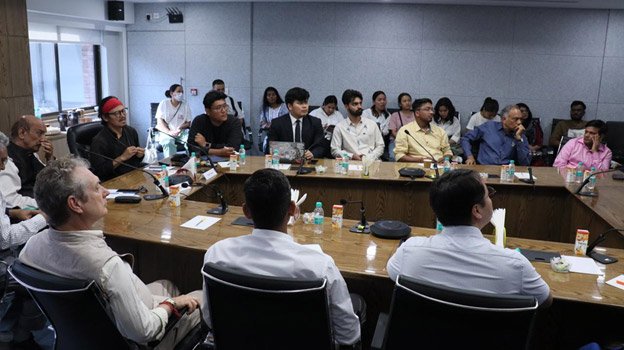
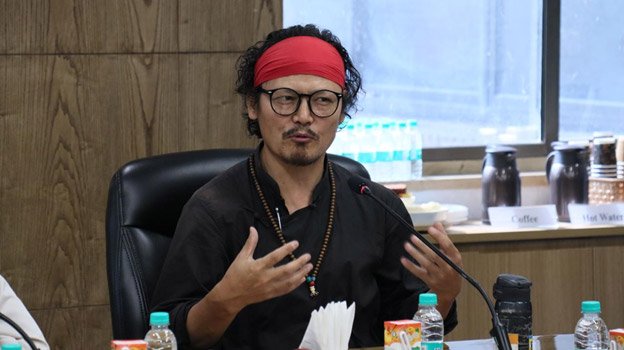
Rajasthan Young Thinkers Meet
Under the aegis of India Foundation, Rajasthan Thinkers Forum organised the 1st Rajasthan Young Thinkers Meet in Jaipur on 08-10 March, 2024. The Meet was graced by the presence of Shri Kalraj Mishra, Hon’ble Governor of Rajasthan. The Meet was attended by young delegates across Rajasthan.
Interaction with Dr David Santoro, President & CEO, Pacific Forum
India Foundation hosted an interaction with Dr David Santoro, President & CEO of Pacific Forum on March 05, 2024, in New Delhi. Dr Santoro discussed the strategic significance of the Indian Ocean Region (IOR) which is considerable and growing. It consists of vast and diverse maritime geography of several subregions, including the Indian subcontinent, parts of Australia and Southeast Asia, West Asia, and Eastern and Southern Africa.
He highlighted in his lecture how should the United States approach the Indian Ocean Region (IOR). The United States recognizes the importance of maintaining a peaceful, secure, and prosperous IOR. In recent years, Washington has embraced the terminology “Indo-Pacific,” as opposed to “Asia-Pacific,” and in 2018 it renamed the US Pacific Command the US Indo-Pacific Command. Even if US strategy documents say little about the IOR, several US officials have recently stressed that Washington is committed to elevating its engagement there, notably through new partnerships.
Dr Santoro during the deliberations focussed on the problems and challenges. He mentioned that the US bureaucracy is not structured to engage the IOR. The US Department of State approaches it through four different bureaus: African Affairs, East Asian and Pacific Affairs, Near Eastern Affairs, and South and Central Asian Affairs. The US Department of Defense, for its part, separates it into three combatant commands: the Indo-Pacific Command, Central Command, and Africa Command. These divisions make it difficult for the United States to appreciate and address the dynamics of the IOR as a whole, especially maritime developments.
Another problem is that the United States does not include the Western Indian Ocean or the eastern coast of Africa in its conceptualization of the Indo-Pacific, unlike India, Australia, Japan, and a few others. The US framing of the Indo-Pacific coincides with the Indo-Pacific Command’s area of responsibility, which ends with India. That further complicates the US’s ability to craft a unified strategy for the IOR.
Dr Santoro in conclusion strongly advocated that partnering with India, the predominant IOR power, should be priority number one. The United States should build upon the recent flurry of cooperation agreements it has concluded with India and work out ways it can best support Indian activities in the IOR.
International Conference on ‘Integral Humanism: Perspectives of Deendayal Upadhyay and Jacques Maritain’
March 4-5, 2024 at Banaras Hindu University, Varanasi
India Foundation, in collaboration with Pandit Deendayal Upadhyay Chair at Banaras Hindu University, and supported by the Indian Council of Social Science Research (ICSSR), organised an International Conference on ‘Integral Humanism: Perspectives of Deendayal Upadhyay and Jacques Maritain’ on March 4-5, 2024. The conference provided an academic forum to discuss the Indian and Western perspectives on ‘Integral Humanism’, particularly focussing on the views of Deendayal Upadhyay and Jacques Maritain. It aimed to explore various dimensions of the concept of ‘Integral Humanism’, including its social, philosophical and political dimensions along with its economic implications.
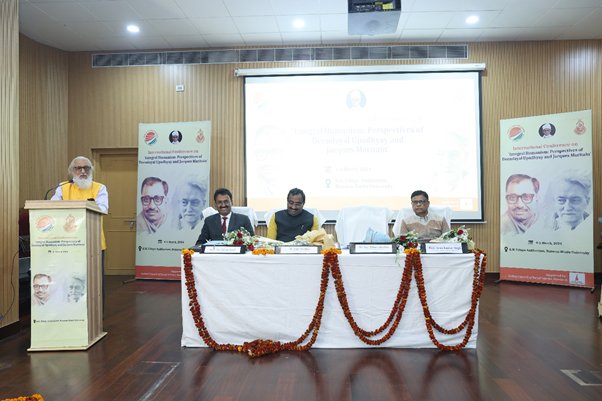
Under the broader rubric of Integral Humanism, the Inaugural Address of the conference on March 04, 2024, was delivered by Prof. Anil Sahasrabudhe, Chairman, National Educational Technology Forum. He focused on Integral Humanism, linking it to the Indian knowledge systems and sustainable development of the society. Discussing the praxis of Integral Humanism in Indian governance, he explained the significance of National Education Policy and its blending of value-based education with holistic development of the human being.

Dr. Ram Madhav, President, India Foundation, delivered the Keynote Address in the Inaugural Session of the Conference. He emphasized on the philosophical foundations of Integral Humanism as propounded by Pt. Deendayal Upadhyay and Jacques Maritain. He highlighted upon the idea of ‘Integral Humanism’, and delved on the convergences and divergences of both the thinkers. He explained how Pt. Deendayal Upadhyay developed the idea of ‘Integral Humanism’ from the concept of ‘Dharma’, while Jacques Maritain derived his theory of ‘Integral Humanism’ from ‘Christendom’. Despite the cultural differences, both the thinkers displayed striking similarities in their thought and raised common concerns sharing a commitment to the holistic development of human beings within the framework of a just and harmonious society.
The Inaugural Session was chaired by Prof. Arun Kumar Singh, Registrar, Banaras Hindu University. Prof. Tej Pratap Singh, Pt. Deendayal Upadhyay Chair at Banaras Hindu University, delivered the Welcome Address. The Inaugural Session of the conference brought together eminent academicians and senior scholars, thinkers and philosophers from across India and abroad to deliberate on the theory and praxis of Integral Humanism as it has evolved both in India and the West. The conference was attended by eminent faculty members, research scholars, and students of Banaras Hindu University, and eminent citizens of Varanasi.
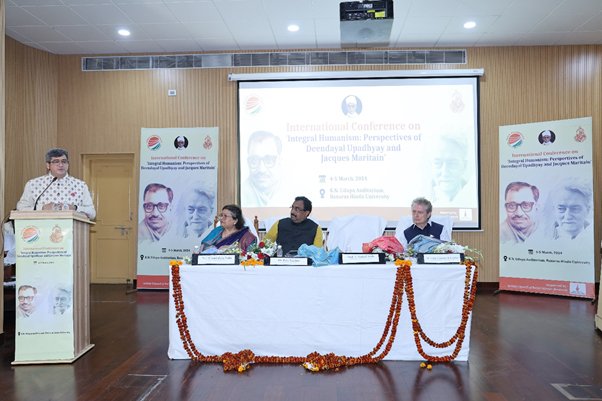
Dr. Ram Madhav, President, India Foundation, chaired the Plenary Session on ‘Integral Humanism of Deendayal Upadhyay and Jacques Maritain: A Comparative Study’ on the first day of the conference. The session was addressed by eminent scholars including Prof. Chandrakala Padia, Former Vice Chancellor, Maharaja Ganga Singh University, Prof. Timothy Samuel Shah, Distinguished Research Scholar in Politics, University of Dallas, and Mr. Come Carpentier, Distinguished Fellow, India Foundation. The speakers elaborated on the philosophical, social and cultural roots of Integral Humanism, both in the worldview of Pt. Deendayal Upadhyay and Jacques Maritain. Through a structured comparative analysis of both the thinkers, they highlighted the overlapping spaces in their worldview, which provided promising avenues for further research on the subject, and showed the possibility of sparking a global dialogue on Integral Humanism.
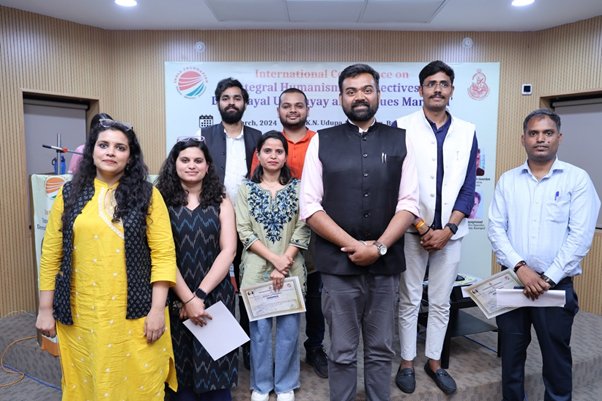
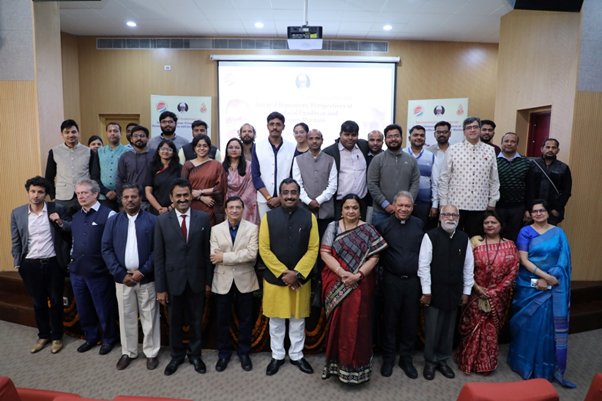
The Plenary Session was followed by two parallel sessions of academic paper presentations by young scholars, budding researchers and professors, on the broad theme of Integral Humanism. Scholars from various academic institutions put forth their arguments and ideas about Integral Humanism, situating them either in a comparative analysis or by developing on the practical and theoretical aspects of Integral Humanism. The two parallel sessions were chaired by Prof. Amarnath Mohanty, Head, Department of Political Science, Banaras Hindu University (BHU), and Dr. Guru Prakash Paswan, Visiting Fellow, India Foundation.

On March 05, 2024, Day 2 of the Conference began with the Special Keynote Session on the theme of the conference. The Special Keynote Address was delivered by Prof. Santishree Pandit, Hon’ble Vice Chancellor, Jawaharlal Nehru University. The session was chaired by Prof. R C Sinha, Former Chairman, Indian Council for Philosophical Research. Prof. Pandit delved into the spiritual and cultural roots of the idea of Integral Humanism. The session was moderated by Dr. Sonu Trivedi, Distinguished Fellow, India Foundation.
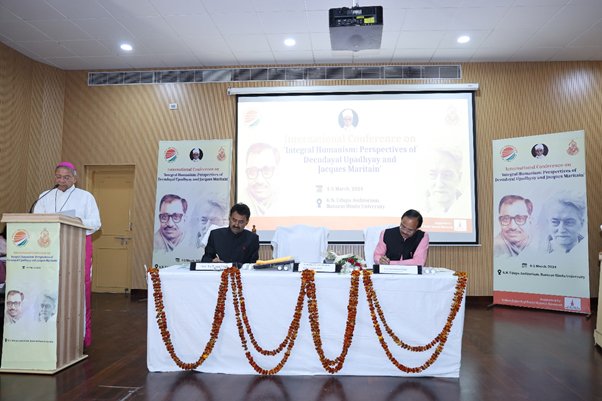
The first working session on ‘Social Dimension of Integral Humanism’ was addressed by Prof. Shri Prakash Singh, Director, South Campus, University of Delhi, and Archbishop Dr. Felix Machado, Diocese of Vasai, India. The session was chaired by Prof. Tej Pratap Singh, Pt. Deendayal Upadhyay Chair at BHU. The session sought to take a deep dive into the socio-cultural framework of Integral Humanism and contextualize its tropes in the respective Indian and Christian religious frameworks.

The second working session was on the theme ‘Philosophical and Political Aspects of Integral Humanism’. The session was chaired by Prof. R. C. Sinha, Former Chairman, Indian Council for Philosophical Research. It was addressed by Prof. Claude Vishnu Spaak, Head, Philosophy and Sociology Department, Sorbonne University, and Prof. K. Jayaprasad, Dean, School of Global Studies and former Pro-Vice Chancellor of Central University of Kerala.
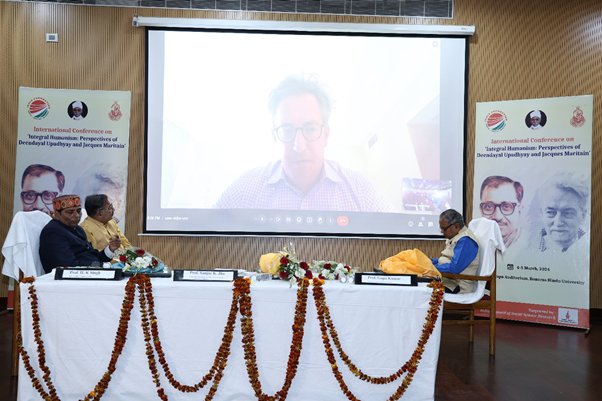
The third working session was themed ‘Economic Implications of Integral Humanism’. The session was addressed by Prof. Gopa Kumar, Former Vice-Chancellor, Central University of Kerala, Prof. Sanjay K. Jha, Dean, School of National Security Studies at Central University of Gujarat, and Mr. Alexis Rostand, Managing Director, Eiffel Investment Group. Prof. H. K. Singh, Dean, Faculty of Commerce, BHU, chaired the session. The economic policies of the state, the concept of Antyodaya, and the centrality of dignity of an individual in formulation of policies driven by the ideas of Integral Humanism were some of the discussion points that featured prominently in the session.
Through their analysis and critical appreciation of the works of both Pt. Deendayal Upadhyay and Jacques Maritain, the speakers in the conference explained how Integral Humanism, as a philosophical and political concept, finds expression in the works of thinkers from diverse cultural and ideological backgrounds. Pandit Deendayal Upadhyay, a key thinker of Bharatiya tradition, developed the concept of Integral Humanism in the context of post-independence India. Rooted in Indian cultural and spiritual traditions, his integral humanism emphasizes the integration of material progress with spiritual and ethical values. According to Deendayal Upadhyay, “body, mind, intelligence and the soul – these four make up an individual which are all integrated. We cannot think of each part separately.” The concept of Integral humanism as developed by Deendayal Upadhyay looks upon life as an integrated whole.
The comparative analysis of Integral Humanism as articulated by Deendayal Upadhyay and Jacques Maritain reveals the universality of certain principles despite the cultural and religious diversity of their contexts. Both thinkers offer valuable insights into the promotion of human dignity, ethical governance, and the integration of material and spiritual dimensions in the pursuit of a just society. The conference marked the initiation of a global dialogue across cultures and civilizations, inspired by the idea of Integral Humanism.
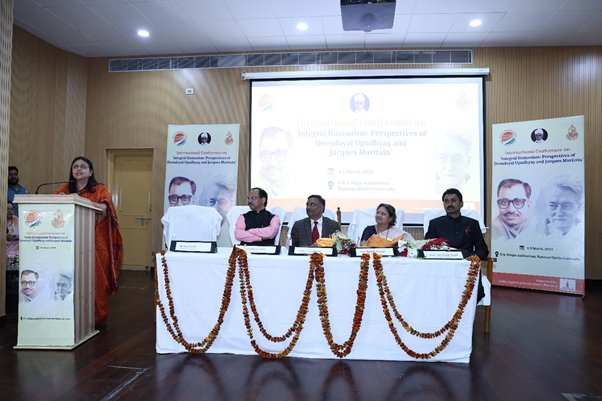
Prof. Binda D. Paranjpe, Dean, Faculty of Social Sciences, BHU, chaired the Valedictory Session of the conference. The Valedictory Address was delivered by Prof. Shri Prakash Singh, Director, South Campus, University of Delhi. Prof. Singh shed light on the continuing significance of Integral Humanism for the shaping of India’s academic discourse and explained its potential to transform Indian public policy and governance. Prof. S. N. Sankhwar, Director, Institute of Medical Sciences, BHU, attended the session as the Guest of Honour. The concluding remarks were delivered by Dr. Sonu Trivedi, Distinguished Fellow, India Foundation.
Interaction with a delegation from Mizuho Corporate Bank, Japan
India Foundation hosted an interaction with Mr Noriyuki Urabe and Mr Katsumi Onishi from the Global Strategic Advisory Department of Mizuho Corporate Bank, Japan, on 05 March, 2024 in New Delhi.
Interview with H.E. Mr. Ranil Wickremesinghe, President of Sri Lanka, on Indian Ocean
Shekhar Sinha: Excellency, thank you very much for giving us time to just pose a few questions. Yesterday, you made a very strong pitch, warning that the intense geopolitical competition in the region has the possibility of spilling over into the Indian Ocean. You also expressed concern over what is happening in West Asia. In your opinion, what are the chances of this spilling over, and can the Indian Ocean region remain a zone of peace in this kind of situation?
Ranil Wickremesinghe: The Indian Ocean must remain a zone of peace. What has happened in my view on the situation in West Asia is because of the American backing of the war in Gaza and the bombing. It is not American’s backing Israel, which everyone expects, and which America does. But because of the US backing for the Gaza war, which has created a lot of prejudice and antagonism against the US, especially amongst the Indian Ocean littorals, where you have the Islamic countries all the way down to Indonesia. The popular reaction is against the US. Now, even if the governments want to maintain close cooperation, it may not be possible for a few years. Remember, few years count a lot in geopolitics. Two years is big in geopolitics, so that’s really going to be an issue for the US. Secondly, as I said, the West tried to break Russia economically, but Russia has succeeded in coming into the Indian Ocean. They already had a good relationship with India, which is continuing and they now have a strong relationship with China. They also have good relations with a lot of other countries in the region, especially with Iran, and they have come into the Bay of Bengal. So, in a way, America has brought Russia in here, and they have created antagonism against themselves. China has been there anyway, and Iran is also active. So, it’s going to be difficult. For the US, especially this year, which is the election year, they can’t be very active. So, two years out with antagonism when the new administration comes or the present administration changes its policy. And two-three years can have a big impact. As Harold Wilson said, “one week is a long time in politics.”
Shekhar Sinha: So that brings me to the next question. How can countries in the IOR, the immediate littorals, keep out of this great power competition?
Ranil Wickremesinghe: I think we have all got to agree on some basics and we’ve worked it. This does not mean that great powers should not be there in the Indian Ocean. Like India, they have to be in the ocean, and they will be there, and they are taking part in exercises like against the Somali pirates. But basically, we must agree on the freedom of navigation in the Indian Ocean and how we control great power rivalry in the area. India and Sri Lanka especially have been very active from the 1940s, from the time of independence. Other countries, like South Africa, I think we can talk to them. You can also talk with countries like the US, China and all others. If we agree, then others have to fall in line. We are not saying don’t be there, don’t have your bases. China has bases. Japan has one base. You can’t say no to them. America has one in Asia, but we have to control what happens.
Shekhar Sinha: Do you recommend that our immediate 4-6 countries who are impacted by this geopolitical competition or likely to be impacted, should have a consensus generating mechanism?
Ranil Wickremesinghe: We should have a consensus generating mechanism, I think, for three things: political issues, trade and for ecology, which is a big issue now.
Shekhar Sinha: Do you envision something like an EU-type of parliament?
Ranil Wickremesinghe: I do not think we need to have an EU-type of model, but there can be understandings and agreements. I can’t see Indian Ocean countries forming a parliament of that nature. It is just too big. I mean basically, we have very big numbers. We have India on one hand, then there’s Indonesia, Bangladesh, Pakistan, and Iran. All are big countries and we are not even looking at the East African coast. But it will be a powerful one by 2050. My idea is going to be powerful. India will have, as I mentioned, a GDP that might even go up by about 8 times. Indonesia will go up, so just imagine if others too also go up four times.
Shekhar Sinha: Sincerely hope so. That brings me to the immediate neighbourhood. Do you see the requirement of a joint HADR type of organisation so that we can come to the assistance of let’s say, Bay of Bengal?
Ranil Wickremesinghe: We should work on it. I think in time to come, Maldives is going to be in trouble. Maybe even Seychelles. I think we have to do it. We have to have these agreements. Basically, one thing that worries me is the melting of the Himalayas and the impact on Bangladesh, India, Sri Lanka, and on the Bay of Bengal.
Shekhar Sinha: What is your view on, let’s say, intertwining of the economies of Indian Ocean countries or maybe the immediate neighbourhood?
Ranil Wickremesinghe: We are for it. That’s why we are upgrading our agreement with India from FTA to the Comprehensive Economic and Technological Agreement. We also want to enhance our agreements with Bangladesh. We are applying to RCEP, so that from India all the way to Japan and Australia will be in one free trade zone. We have to work this out. Of course, India didn’t join RCEP, but I’m sure RCEP would be more than happy to have some agreement with India and Bangladesh. So, let’s say, at least from India, from Mumbai all the way to Tokyo and down to Melbourne, let’s have an agreement.
Shekhar Sinha: That I think is a very workable proposition.
Ranil Wickremesinghe: That’s what we have to do, yes.
Shekhar Sinha: Just one more question related to this. Do you see any specific 2-3 points which the island nations would like India to lend their hand in?
Ranil Wickremesinghe: Others are small island nations. But with us, we are looking at closer integration with India. That’s why we are looking at connectivity, financial connectivity, energy connectivity, land connectivity. So that this is the age in which countries work closely. Bangladesh already has with India, so Sri Lanka too will work on this.
Shekhar Sinha: Last question, if you permit. I know you have to leave shortly for the airport. We, you know, with Sri Lanka have been very good at handling the big power competition or rivalry so to say and you have been at the apex for so many years in various capacities. Do you think that it is now possible for Sri Lanka to have a role in reducing the friction between these 2-3 countries?
Ranil Wickremesinghe: I think those countries have to do it themselves. India and China had a very good relationship. I think there are few outstanding issues. What we can do is to ask them to sort it out. But I think getting into the middle of it, that is not our field. but I think there has been a lot of, I must say in the last 5-10 years I’ve seen a lot of interaction between India and China. We could ask for a few areas, especially the Himalayas that have to be sorted out. We would like to help in any way, if it would make a difference. All of a sudden Asia comes up with two big powers coming in here, but let’s see how we can work it out. It will take a bit of time but we all hope it can be done. And actually, the India Foundation is more than good to start talking on these issues.
Shekhar Sinha: How do you see the Indian Ocean’s role in the larger Indo-Pacific construct?
Ranil Wickremesinghe: The Indian Ocean has been quite different from the Pacific, but we are connected. We have to accept that. It’s a different one, and for thousands of years, it’s sort of evolved. I mean, basically if you look at it in that context, I think we should build on what is there. Now look at India. You had linkages all the way down to South Africa; Indians have gone down there. They are out there in Australia. We have people. It’s easy for us to sit down, I think and talk it over. It’s different in the Pacific Islands as they’re getting together. They haven’t had those cultural relations. And if you look at it basically, the Ramayana has taken you all the way to Vietnam. Theravada Buddhism has also taken us all the way to Vietnam. So, these are type of links we have. And remember, it is from India that Buddhism went to China; the Taoist Temple is one such example, even in Tibet. So, these links are there within Asia and it is very big. It was the Arab traders and the Indians who’ve been trading with each other. Such a unique relationship exists maybe in the Mediterranean, but certainly not between the Atlantic powers or between the Pacific. So, we have something to build on. And we’ve also been part of the British Empire or the Dutch Empire or the French Empire, so we can work on it.
Brief Bios:
- His Excellency Mr. Ranil Wickremesinghe is the President of Sri Lanka.
- Vice Admiral (Retd.) Shekhar Sinha is the Chairman of the Board of Trustees, India Foundation.
The Notion of Welfare by State in Early India
Introduction
The concept of a welfare state is considered a modern formulation, wherein, to reduce the ill-effects of an industrial society, the state provides basic provisions for its citizens, through interventions in healthcare, education, employment, housing, old age pension etc. Otto von Bismarck, who served as the first chancellor of the German Empire, is usually credited with the establishment of the first modern welfare state of an industrial society in the 1880s by rolling out several social welfare programs for ordinary Germans. However, the roots of such a concept go back to ancient India, wherein the notion that the protection of life and livelihood of its subjects is the prime responsibility of the state, was deeply ingrained in the socio-political thought of that time.
In the sixth century BCE, Gautam Buddha had recommended that the king should adopt measures for the upliftment of the living conditions of the people. Political treatises like Arthashastra instruct a king to place the welfare of his subjects among his foremost duties and expend state treasury on public works. The Mauryan ruler Ashoka undertook several welfare activities including the provision of medical facilities for the well-being of his subjects and also propounded a policy of Dhamma through his edicts, for promoting an atmosphere of concord and harmony in the society. Apart from Ashokan inscriptions, some other epigraphical records provide evidence of the welfare programmes undertaken by the Mauryan state. These are only a few examples that highlight some of the best practices that existed in early India.
The Notion of Welfare and State in Ancient India
Well-being or welfare of all is a recurrent theme in ancient Indian doctrines. Religious texts as well as various secular treatises of the ancient times are replete with concern for the happiness of every individual and society at large. The Dharmashastras emphasise that the well-being of an individual and the entire society can be achieved by the pursuit of the fourfold Purusharthas i.e. the great aims of human endeavour, at an individual level. These are – Dharma, Artha, Kama and Moksha which can be roughly translated as moral behaviour, wealth, worldly pleasures and salvation. An individual can have a meaningful sustained life and even achieve salvation after life, by earnestly pursuing these goals. Gautam Buddha, the founder of Buddhist philosophy, advocated the Atthanga-magga or the Noble Eight-fold path as a way of removing the root cause of suffering and overcoming desire. This path is actually the Middle Path of moderation between extreme indulgence and extreme asceticism which can lead to the attainment of ‘nibbana’ or salvation i.e. deliverance from the cycle of birth, death and rebirth. It consists of the right view, right intention, right speech, right action, right livelihood, right effort, right mindfulness and right concentration. Apart from these spiritual interpretations of welfare, the close connection between the overall happiness and material conditions of people is recognised and the development of material well-being too is emphasised in these philosophical discourses.
The period around the sixth century BCE witnessed the emergence of several territorial states in north India. This process was accompanied by the rise of urban centres and expansion of agriculture and trade, leading to increase in socio-economic stratification. Buddhist and Jain texts enumerate 16 powerful mahajanapadas or states that flourished in India in the sixth century BCE, and try to offer an explanation for the process of state formation. According to Mahabharata (Velakar, 1948), state is a creation of gods and initially Virajas, but later Prithu was chosen as the King by sages, to purge an anarchical situation encapsulated in the term, matsyanyaya (law of the fish). Buddhist canonical texts provide an anthropological interpretation for the creation of states in Digha Nikaya (the book of long sayings) which envisages a type of a social contract, close to the one propounded by modern European political thinkers. In the Agganna Sutta (‘pertaining to beginnings’) it is stated that in face of an anarchical situation, men deliberated and elected a Mahasammatta, the Great Elect, to enforce justice for which they offered him a share of their harvest. With passage of time he became the Dharmaraj (the righteous king) and brought happiness to men by establishing Dharma i.e. rule of law. In the Cakkavatti-sihanada Sutta, the cakkavatti or universal monarch is hailed as the guardian of ethical authority. It is divulged that in order to solve social problems and dispel economic inequalities caused by inequitable distribution of wealth, the state has the right to enforce legislative power (Walshe, 1995).
At a general level, Buddha was aware of the importance of material well-being of an individual and the society at large. He recognised that if the poor are not able to produce wealth, it leads to poverty, which is at the root of immorality, theft, falsehood, violence, hatred, cruelty, etc. In Digha Nikaya he recommended some measures for eradication of poverty, such as provision of grain and other facilities to farmers, providing capital to traders and adequate wages to labour. These welfare activities provide a justification for the state and the taxation system. Like a pragmatist, he recognised that the way to control crimes in the society was to uplift the living condition of people by purging them from poverty and the king or state had a role to play in this scheme.
Kautilya’s Arthashastras and its Ideal King
Arthashastra, the Sanskrit classic text on statecraft, is traditionally considered a work of the fourth century BCE, written by Kautilya, also known as Vishnugupta or Chanakya, the chief minister of the first emperor of the Mauryan dynasty, Chandragupta Maurya. This political treatise is normative in nature, containing detailed prescriptions and proscriptions for the administration of a state by its ruler. It consists of 15 adhikaranas or books dealing with various aspects of internal administration (tantra), relations with the neighbouring states (avapa) and other miscellaneous subjects. It categorically states that artha (material well-being secured through livelihood) is superior to dharma (spiritual well-being) and kama (worldly pleasures) as the latter two are dependent on it (Singh, 2008: 322). It contains the description of the circumstances of the origin of monarchy in Book I. It states that when people were oppressed by the matsyanyaya (law of the fish according to which the bigger fish swallow the smaller fish) they chose Manu as their King and fixed one-sixth portion of the grain and one tenth of their goods and money as his share. It further proclaims ‘Kings who receive this share are able to ensure the well-being of their subjects’ [Arthashastra 1.13.5-7]. This theory seems to describe something like an original contract for the establishment of monarchy in which people agree to pay taxes to a monarch so that he can ensure security and well-being i.e. yoga-kshema of all.
This manual on statecraft frequently refers to the obligations of a ruler towards his subjects and lays down three-fold duties for him in the internal administration of the country viz. raksha, palana and yoga-kshema. Raksha primarily means the protection of the state from external aggression as well as protection of the person and property of his subjects. The entire Book Four, called kantakashodhan, is devoted to suppression of crime and protection of people from anti-social elements like deceitful artisans and traders, thieves, dacoits and murderers, as well as their protection from natural calamities such as fire, floods etc (Kangle, [1965] 2010:117). Palana can be interpreted as the provision of security by maintenance of law and order within the state. Book Three is concerned with law and its administration as it contains a complete code of law. Yoga-kshema implies the idea of welfare, well-being, including the idea of safeguarding the happiness and prosperity of the people. In Book One it is enjoined ‘In the happiness of his subjects lies the happiness of the king; in their welfare his welfare. He shall not consider as good only that which pleases him but treats as beneficial to him whatever pleases his subjects’ [Arthashastra 1.19.34].
The political treatise defines welfare as ‘the increase in economic activity, the protection of livelihood, the protection of vulnerable segments of society, consumer protection, the prevention of harassment of citizens, and the welfare of prisoners and labor’. In order to ensure the economic well-being of the people through increased opportunities of livelihood, Book Two advised the ruler to undertake a host of productive activities. They include activities such as sunyaniveshana i.e. settlement of virgin land; setubandha i.e. building of dams, tanks, wells and other irrigation facilities; vraja i.e. providing pasture for cattle; vanikpatha i.e. opening trade-routes and ensuring safety on them; khani i.e. working of mines; exploiting timber and elephant forests; construction of places of punyasthana or pilgrimage, groves and roads for traffic both by land and water; setting up of market towns, industries and manufacturing units and so on [Arthashastra 2.1.1,19-20]. The king is advised to provide new settlers with seeds, cattle, tax concessions and remissions in initial years and even cash in form of loans to help them reclaim land and expand agriculture [Arthashastra 2.1.13-14]. The king may provide sites, roads, timber and other necessary things to those who construct reservoirs on their own record. On one hand these undertakings provide livelihood to people and furthered the welfare of the subjects, on the other hand they expanded the economy and augmented the resources of the state. It is recognised that a flourishing economy is beneficial for both the state and its people.
Arthashastra advises kings to take into account the welfare of all beings in formulating state policies. The interests of the subjects should be allowed to prevail over the interest of the state. It directs that the sale of commodities, imported or indigenous, should be arranged in such a manner that it is beneficial for the subjects while any profit that may be harmful to the subjects should be avoided [Arthashastra 2.16.4-6 & 4.2.27,35]. A paternalistic ideal is set before the ruler. In accordance with this attitude, it is argued that the kingdom will prosper only if the King regards his subjects with the same concern as a father regards his children. It is stated that when the subjects are struck down by natural calamities, the ruler should take care of them like a father [Arthashastra 4.3.43]. The third chapter of Book Four provides details of measures to be taken for the relief of the subjects in case of natural calamities like floods, fire, epidemic, famines etc (Kangle, [1965] 2010: 234). It recognises that like the head of a family has a responsibility of the extended family, the king or government has a crucial role to play in providing security and maintaining the material well-being of the entire country and its people. It is laid down that the king should provide maintenance for the orphans, minors, the aged, the infirm, the afflicted and those in distress, who have no one to look after them. He is further asked to provide subsistence to the helpless women when they are carrying and also to the children they give birth to as well as childless women [Arthashastra 2.1.18-26]. It asserts that the King shall protect agriculturists from the molestation of oppressive fine, forced labor and unjust exactions from corrupt officials; herds of cattle from thieves, animals and cattle disease; clear the roads from molestations of courtiers, robbers etc and even protect them from being destroyed by herds of cattle. Punishment is laid down for officers who are responsible for extortion from the subjects [Arthashastra 2.9.15-16]. The text lays down the minimum wages for laborers and herdsmen as one pana (silver coin) and a quarter per month over and above the food for them and their families [Arthashastra 2.24.28]. It elaborates rules concerning the proper treatment to be given to dasas (slaves), and debt bonded labour, both male and female, and provides appropriate penalties for their violation. These rules insist on a humane treatment for various kinds of slaves and emphasise their right to freedom on the payment of a ransom-amount. The text provides for stringent checks against fraudulent practices in trade like adulterating goods or manipulating prices or giving short weight and measures etc. Severe punishments are laid down for prison officers exceeding their authority by harassing, assaulting or maiming prisoners or criminally approaching a female prisoner or even preventing them from taking their meals or answering nature’s calls [ Arthashastra 4.9.21-27].
The rules about the construction of prison-house include construction of separate wards for males and females, with halls, sanitary arrangements, provision for protection against fire and even provision for worship [Arthshastra 2.5.5-6]. It is stated that out of the various kinds of tortures recommended for securing a confession of a crime, only one torture is to be applied on any one day and there is to be no torture on two successive days. Torture is prohibited in the case of a pregnant women or a woman in the first month after delivery. The King is advised to use his power of danda i.e. coercive power of the state, to ensure the protection of the subjects and to enable the weak to hold their own against the strong. He is nevertheless advised to use danda with great care as a just use of this power secures the protection of people along with the happiness of the ruler, while its unjust use could have serious implications leading to discontentment or disaffection of his people, the most serious being a revolt of the subjects against the ruler [Arthashastra 1.4.12].
The text lays a lot of emphasis on starting productive enterprises and pursuing successful economic policies that create means of livelihood under state control. These recommendations are not just altruistic measures, but have a clear aim to augment the revenues of the state and appropriating surplus for the state treasury. At the same time the treatise warns, a King who impoverishes his own people or angers them by unjust exactions will lose their loyalty [Arthashastra 7.5.27]. Thus, a fine balance needs to be maintained between the welfare of the people and enhancing the resources of the state. The maintenance of law and order through an efficient administrative as well as just judicial machinery is one of the primary responsibilities of a state. The entire Book Four is devoted to the suppression of criminal activities with provision of punishment to thirty kinds of criminals as well as other anti-social elements like deceitful merchants, corrupt officials etc, who are identified as thorns of the society. It is recognised, ‘A king meting out unjust punishment is hated by the people he terrorises while one who is too lenient is held in contempt; whoever imposes just and deserved punishment is respected and honoured [Arthashastra 1.4.7-10]. While exploring issues of social welfare, the text advises the king to create buffer stocks of grains and other products in state stores to prevent a wide fluctuation in prices and also to create reserve stock which could be distributed during natural calamities, giving tax exemptions to the affected population and initiating public projects such as building forts around major strategic holdings, construction of irrigation waterways for its people. It also lays down regulations for the protection of wild life, providing a long list of punishments for cruelty to animals, provisions for veterinary doctors, creation of animal sanctuaries etc.
The ideal ruler, according to Arthashastra is one who takes care of his subjects like a father, invests in the economy to augment the resources of the state as well as its people, maintains law and order through an effective administrative machinery and a just judicial system, guards against fraudulent practices and provides support to ‘ those who have necessarily to be maintained’ by the state [Arthashastra 1.12.1]. It enumerates the seven essential elements of the state as svamin, the King; amatya, the minister; janapada, the territory settled with people; durga, the fortified capital; kosa, the treasury; danda, the army or justice and mitra, the ally. However, it needs to be kept in mind that this manual on statecraft is normative in nature. The detailed prescriptions and injunctions are mere recommendations for a king which could be put into practice by a well-intentioned ruler. In a monarchical setup a great deal often depended on the personality and will of the particular ruler. Instead of reflecting the reality of the times the text mirrors the ideal of its times which aims at welfare of all.
Ashoka and his Dhamma
The well-being of his people through the propagation of dhamma was the primary concern of the Mauryan emperor Ashoka. Ashoka’s inscriptions are divided into two main categories, the 14 major rock edicts, including Separate Rock Edict 1 and 2 of Dhauli and Jaugada, and the seven pillar edicts that are discovered in different places all over India with minor variations. These inscriptions provide an insight into Ashoka’s ideas about his role as a king and even his own assessment of his success at dissemination of Dhamma. The ideals of kingship as discerned through his edicts on Dhamma include ensuring the welfare of all beings and his subjects in this world and the next. In Separate Rock Edict 1, exhibiting a paternal attitude he expresses, ‘All men are my children. Just as with regard to my own children, I desire that they may be provided with all kinds of welfare and happiness in this world and the next world, I desire the same for all men’. He sought to ensure peoples’ welfare by planting beneficial medicinal herbs, roots and fruit bearing trees and digging wells along the roads, building resting places and providing medical care for people as well as animals in his empire (Major rock edict 2). Ashoka created a special cadre of dhamma mahamatras in the 13th year after his consecration, to spread the message of Dhamma within the kingdom and among border people. They were given the responsibility of promoting the welfare of prisoners and releasing those who were afflicted, aged or had children, organising charities and working for the welfare and happiness of all sects (Major rock edict 5). The ceremony of Dhamma is described as consisting of proper courtesy to slaves and servants, obedience to mother and father, generosity towards friends, relatives and acquaintances as well as Brahmanas and Shramanas, and abstaining from killing living beings (Singh, 2008: 352).
Generation of an atmosphere of concord and mutual respect among people of different religious communities is an important aspect of Ashoka’s Dhamma, which aims at the welfare of all. In Major rock edict 12 he urges people to exercise restraint in praising their own sect and in criticising other sects, while trying to honour and understand each other’s religion. In the 6th pillar Edict, Ashoka states that the purpose of his edicts was a concern for the welfare and happiness of his subjects, who, if they ordered their lives according to the principles of Dhamma, would attain happiness in this world and in the next world too. Major Rock Edict 6 and Separate Rock Edict 2, refer to the debt that he owes to all living beings, which he wanted to discharge by fulfilling his most important duty of promoting the welfare of the whole world, remaining in touch with people’s affairs at all times and promptly dispatching public business. He instructs ‘At all times, whether I am eating, or am in the women’s apartments, or in my inner apartments, or at the cattle-shed, or in my carriage, or in my gardens- wherever I may be, my informants should keep me in touch with public business’ (Major rock edict 6). It is through the practice of such a Dhamma, Ashoka desired to enhance the well-being of all men as well as animals inhabiting his empire.
Other Inscriptional Testimonies
The epigraphical testimonies of Sohgaura, Mahasthan and Junagarh\Girnar inscriptions provide evidence of some of the welfare activities undertaken by the Mauryan state. The Sohagaura inscription of Gorakhpur is a short inscription of four lines that recorded an order by the mahamatras of Shravasti to distribute and not withhold, the contents of the storehouses of five places—Triveni, Mathura, Chanchu, Modama, and Bhadra, in case of outbreak of drought. The Mahasthan inscription from Bagura district of Bangladesh records an order to the mahamatra of Pundranagar, to take adequate measures to relieve distress caused to people on account of famine. The measures undertaken included the advancing of a loan in coins and distribution of paddy from the granary to help them tide over the calamity (Hazra, 2002:43-60). The Girnar inscription of Junagarh records that the construction of a water reservoir known as the Sudarshana Lake was begun during the time of Chandragupta Maurya and completed during the reign of Ashoka. These famine relief measures and construction of irrigation facilities would have surely provided respite to the distressed population of the concerned area. These inscriptions, along with the internal evidence of Ashokan edicts sufficiently demonstrate that the early Indian state, especially during the Mauryan period, recognised its responsibility and played an active role in advancing the welfare of its subjects. The Mauryan state expended state treasury on the construction and maintenance of roads, wells, and rest-houses, of building irrigation facilities such as the dam on the Sudarshana Lake in Girnar, providing medical treatment for men as well as animals, and planting of mango-groves, banyan trees, medicinal herbs, roots and other useful trees.
Conclusion
The idea of advancement of welfare of people through active state intervention is clearly envisaged in the socio-political doctrines of ancient India. Welfare measures like enhancing economic activities, providing employment opportunities, investing in public works, relief measures during calamities, medical facilities, accountability and accessibility of the king, safeguards against fraudulent practices etc are some of the ideas that comprise the notion of welfare in the texts and inscriptions of early India. While the onus of enhancing mental and spiritual well-being of an individual lies on the concerned person, the responsibility of ensuring material welfare and social justice is largely recognised as the responsibility of the state or the government of the day.
Author Brief Bio: Dr. Pallavi Prasad is a Professor in the Department of History, Satyawati College, University of Delhi.
REFERENCES
● Hazra, K.L. 2002. Buddhism and Buddhist Literature in Early Indian Epigraphy. New Delhi: Munshiram Manoharlal
● Hultzch, E. [ 1925] 1969. Corpus Inscriptionum Indicarum. Vol. 1, Inscriptions of Asoka. Reprint edition. Delhi: Indological Book House. ● Kane, P.V. [ 1941]. History of Dharmashastra. Vol. 1, Part 2. Poona: Bhandarkar Oriental Research Institute.
● Kangle, R.P. 1960-65. The Kautiliya Arthasastra. Vol I, II& III. Bombay: University of Bombay.
● Rangarajan, L.N. 1992. The Arthashastra. New Delhi: Penguin Books. ● Rhys Davids, T.W. [1910] 1951. Dialogues of the Buddha. Part II. Sacred Books of the Buddhist Series, Pali Text Society.3rd edn. London: Luzac and Co.
● Shamasastri, R. [1909]1960. Arthashastra of Kautilya. Mysore ● Sharma, R. S. 1983. Material Culture and Social Formations in Ancient India. Delhi: Macmillan India.
● Singh, Upinder. 2008. A History of Ancient and Early Medieval India. Delhi: Pearson.
● Thapar, Romila. [ 1963] 1987. Asoka and the Decline of the Mauryas. 7th rep. Delhi: Oxford University Press.
● Velakar, H.D. 1948. Mahabharat. Vanaparva. XII
● Walshe, Maurice O’ C.1995. The long discourses of the Buddha: a translation of the Digha Nikaya. Boston: Wisdom Publications.
Roundtable Discussion with a delegation from Taiwan
India Foundation organised a roundtable discussion on February 29, 2024 with a visiting delegation from Taiwan which included Chih-yu Shih, Professor, Department of Political Science, National Taiwan University; Simon Tengchi CHANG, Professor, Department of Political Science, National Taiwan University and Tien-sze Fang, Associate Professor, Center for General Education, and Deputy Director, Center for India Studies, National Tsing Hua University, Taiwan. The theme of the roundtable was “Taiwan Elections and its Impact on Cross-Strait Relations” and the discussion was chaired by Capt Alok Bansal, Director, India Foundation. The discussion was attended by many dignitaries from various prolific backgrounds.
The elections in Taiwan were held on January 13, 2024 for its presidency and 113–seats legislature. The elections resulted in the victory of William Lai from Democratic Progressive Party (DPP) and the opposition party being the Kuomintang (KMT). The roundtable discussion revolved around the understanding of Taiwan politics and its impact on major powers of South Asia and the United States.
Chih-yu Shih, Professor, Department of Political Science, National Taiwan University shared his thoughts from a philosophical perspective about the Taiwanese elections and its impact on the population of Taiwan.

Simon Tengchi CHANG, Professor, Department of Political Science, National Taiwan University in his remarks mentioned about the Taiwan 2024 elections results and its implications on the cross strait relations or the trilateral relations amongst Taiwan-China-United States.
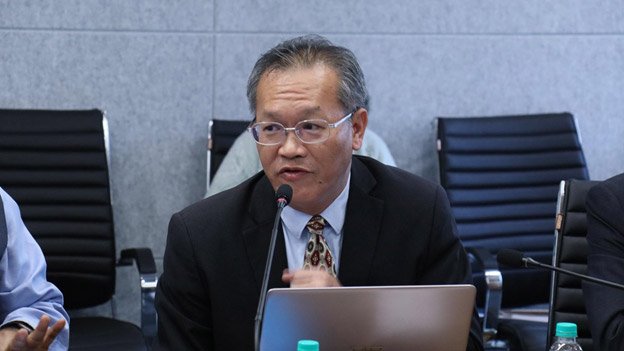
Tien-sze Fang, Associate Professor, Center for General Education, and Deputy Director, Center for India Studies, National Tsing Hua University, Taiwan, in his remarks, proposed for people-to-people connect between India and Taiwan in order to have a reciprocatory cultural, educational and economical exchange between Taiwan and India.
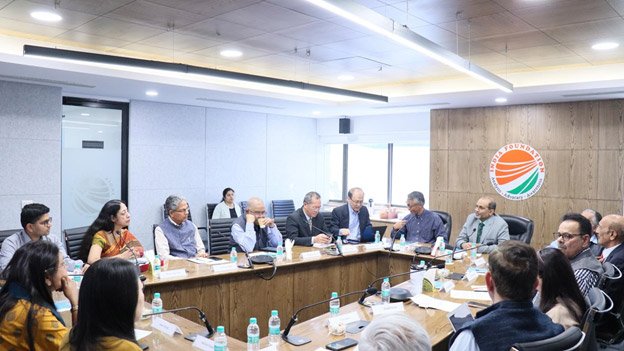
India Foundation Journal: March-April 2024
The Elephant in the Room
Investigating Consciousness Beyond Reductionism
The India Foundation, University of Padova, and the Italian Buddhist Union co-organised an international conference in Padova, Italy themed, “The Elephant in the Room: Investigating Consciousness Beyond Reductionism” on 21-23 February 2024 in collaboration with Mind and Life Europe, the University of Ottawa and the Mind Care Foundation. This conference is the second edition of a series of international events on this theme launched by the India Foundation The conference was addressed by 22 of the leading philosophers, scientists, and scholars across various disciplines, including neurophysiology, physics, psychiatry, and philosophy.
The conference began with opening remarks by Dr. Filippo Scianna, President of the Italian Buddhist Union, Mr. Come Carpentier, Distinguished Fellow, India Foundation and Dr. Alberto Voci, Professor, Department of Philosophy, Sociology, Pedagogy and Applied Psychology – FISPPA, University of Padua. All expressed their satisfaction to participate in the event on a subject of deep scientific, philosophical and cultural importance for the future of humankind. Come Carpentier recalled the contributions to the field of some of the intellectual luminaries who taught or studied at the University of Padova since mediaeval times and he highlighted the need to continue and expand the interactions and collaboration between India and the West in the domain of consciousness research, given the seminal contribution that Indian native knowledge systems have made in this area during thousands of years.
Day 1
Session 1: Insights from Contemplative Traditions
The first session was divided into two panels; the first panel was chaired by Marcello Ghilardi, Professor and Researcher in Aesthetics, University of Padua, and featured two speakers, Paavo Pylkkänen, Senior Lecturer in Theoretical Philosophy, School of Bioscience, University of Skövde in Finland and Sangeetha Menon, Professor & Head, NIAS Consciousness Studies Programme, Indian Institute of Science, Bangalore.
Paavo Pylkkänen began his address with a brief introduction to the reductionist, non-reductionist, and non-illusionist approaches. He discussed the shortcomings of each approach and spoke of Bohm’s wave theory which indicates that pilot waves guide the particles, inferring the possibility of consciousness guiding the mind. He said, “Information exists all around us but is not meant for us. It’s meant for cells and particles, and it makes things happen even without our awareness”.
Sangeetha Menon narrated briefly the story of Nachiketa from Katha Upanishad explaining the Indic understanding of atma. She spoke of the philosophy behind consciousness and touched upon the implications of Artificial Intelligence in consciousness studies.
The second panel of the session was chaired by Ilaria Malaguti, Associate Professor, Department of Philosophy, Sociology, Pedagogy, and Applied Psychology – FISPPA, University of Padua, and consisted of two speakers, Bruno Neri, Professor, University of Pisa and Bindu M. Kutty, Professor, Dept. of Neurophysiology, NIMHANS, Incharge Professor and Coordinator of NIMHANS Center for Consciousness Studies in Bangalore, India.
Bruno Neri briefly summarised the advantages and drawbacks of the reductionist approach to consciousness. He put forward the key question, “Can consciousness be reduced to its neural correlates considering its fundamental nature ?” He derived from his study in a Tibetan monastery in India where he recorded the brain activity of monks during meditation. He provided a neurophenomenological description of brain activity levels across various stages of consciousness during the meditation practices.
Bindu Kutty discussed her study which involved the use of EEG on meditation practitioners during the meditation process and the variations observed based on the techniques of meditation used. According to the study, there was a global enhancement of spectral power indicating entrance into a different state of consciousness in monks which is distinct from the sleep state. She also found direct effects of meditation on cognitive function and flexibility as well as stability of mind.
Session 2: Beyond Duality
The second session was chaired by Silvia Capodivacca, Researcher in modern and contemporary philosophy of the French and German schools (Nietzsche, Deleuze) at Padova, and included two speakers, Catherine Prueitt, Assistant Professor, University of British Columbia, Canada, and Zoran Josipovic, Adjunct Assistant Professor, Department of Psychology, New York University.
Catherine Prueitt spoke from the perspective of the Indian (Pratibhijna) cosmopsychism of Utpaladeva and Dharmakirti clarifying that her approach can be described as a form of priority monism where consciousness is the fundamental individual that defines reality. In other words, she spoke of the Unitary Shiva or the one universal reality. She notes that Shiva tattva is, “consciousness as the infinite variegation able to express itself as any and all manifest worlds” and therefore noted that, according to this approach, space and time are powers of the universal consciousness i.e. they arise out of the processes of universal consciousness.
Zoran Josipovic spoke about the pure awareness and the explicit nature of non-duality stating that consciousness is homogenous and a phenomenon/entity of non-dual reflexivity. He noted, “Inherent non-conceptual reflexivity is unique to consciousness itself, It makes it what it is”
Session 3: Contributions from Physics and Mathematics
The third session was chaired by Marcello Ghilardi, Associate Professor in the Department of Philosophy, Sociology, Education and Applied Psychology at the University of Padova, and had three speakers, Chetan Prakash, Affiliate Member, Association for Mathematical Consciousness Studies, Emeritus Professor of Mathematics, California State University and Senior Lecturer in Aikido, Donal D. Hoffman, Professor of Cognitive Sciences, University of California, Irvine and Federico Faggin, Physicist, Engineer, Inventor and Entrepreneur based in the USA.
Chetan Prakash briefly outlined the history of physics from 19th Century classical physics to 20th century Quantum Theory leading up to a modern realisation, and to a new approach based on the understanding that spacetime has no operational use below Planck’s length (a scale of 10-33 cm and time intervals of 10-43 seconds). Increasing quantum measurement accuracy multiplies the degrees of freedom limited by the blackhole formation. This understanding has led to the formulation of several positive geometries and other mathematical entities. With this background, the Consciousness Realism Hypothesis was introduced, (The world of an agent is a network of consciousness agents) and the experiential dynamics of a single agent was defined by the following formula:
Q (Qualia) = DAP (Decisions Actions Perception)
Donal D. Hoffman further explained the work he and Chetan Prakash were collaborating on, explaining how even within the framework of evolutionary theory, vertical selections go extinct. Elaborating on the limitations of space-time and reductionism as well as on the imminent end of the usability of those approaches as physics and science move forward, he went a step further to say that quantum theory is not fundamental. The team now proposes to use Markov Kernels to study Qualia.
Federico Faggin emphasised that consciousness can’t be explained via anything that isn’t as simple as itself. He said, “ Consciousness is a quantum property of nature” and “space and time are derivative and emergent properties of consciousness”
Day 2
Session 1 Philosophical and Epistemological Inquiries
The first session of the second day of the conference had two panels. The first panel was chaired by Chiara Mascarello, Associate Professor, Department of Asian and Mediterranean African Studies of the University of Padova and listed three speakers, Kathinka Evers Professor of Philosophy and Senior Researcher, Centre for Research Ethics & Bioethics (CRB), Uppsala University in Sweden; Juan Arnau, Philosopher and Writer, professor at the Complutense University of Madrid, Spain, as well as Riccardo Manzotti, Professor, Department of Business, Law, Economy and Consumer Affairs and Faculty of Communication, IULM University, Italy.
Kathinka Evers commented on the Western perspective towards consciousness. She explained that psychological dissociation has 3 forms, dissociation with nature, with the other, and with the conscious self. In the West consciousness has historically been linked to souls which were held to be exclusive to humans. Among humans too hierarchies were assumed; for instance there were debates as to whether women had souls and Darwin himself classified women between children and men. There was also a hierarchy of races: white men had souls while ‘primitives’ from other continents might not have them to the same degree, according to some racist thinkers. The mindset dictated the bias of Western science which supported it with allegedly factual experimental data, making it easier to justify genocide. From this extreme, the West has now swung to the opposite notion, i.e. panpsychism where even elementary particles are hypothesised to have some form of consciousness. Throughout her talk, Dr Evers highlighted the biases and flaws that ‘Western’ science is susceptible to and should be careful of. She also spoke about the risk of humans creating artificial intelligence with the intent of eventually creating conscious machines. Though she believes that this is not possible anytime soon, she wondered whether people have truly thought about the implications of such a development.
Juan Arnau highlighted the understanding of consciousness from three viewpoints, Mahayana Buddhism, Samkhya Philosophy, and the Philosophy of Science. He broke down the difference between consciousness and mind within the Buddhist teaching where mind and matter are categorised together and separate from consciousness. He also explained the Samkhya perspective which states that intelligence, the self and the mind arise from the interaction between pure consciousness (Purusha) and mind-matter (Prakriti). He commented on the ability of science to know reality stating, “Science doesn’t open the pot to see the stew, it cooks the stew”
Riccardo Manzotti brought a different perspective and approach. He proposed a reductionist physicalist view where the object dictates the mind. He noted that the experience does not have material counterparts, therefore, these can’t be accepted as reality. He spoke of the Causal Self-Referential Theory of Perception, i.e. perceptual content is satisfied by an object only if the object in question has caused the perceptual experience. Anticipating a question on dreams and hallucinations he said, “Dreams are extensions of the existent present, based on past events registered”.
The second panel of the session was chaired by, Andrea Gambarotto, Maria Zambrano Fellow, Department of Philosophy, Centre for Research on Life, Mind and Society, Department of Philosophy, University of the Basque Country (Spain) and consisted of two speakers, Sebastjan Vörös, Associate Professor at the Department of Philosophy, University of Ljubljana, Slovenia and Philip Goff, philosophy professor, Durham University, UK
Sebastjan Vörös explored the potential of Francesco Varela’s concept of Dynamic Systems Theory as a way of understanding consciousness. He elaborated on the crucial aspect of autonomous systems i.e. the circularity of their function and underlined the fact that the living being is situated in the environment. He said, “An organism, by enacting itself, enacts its own meaning”. In other words, a living being brings meaning to the external world in its own context, creating its autonomous identity.
Philip Ghoff gave a virtual address on free will and the evolution of consciousness. He highlighted the mystery of Psycho-Physical Harmony. He explained his version of panpsychism where consciousness is not confined to biological entities but is a fundamental feature of all physical matter. He explained how our current scientific paradigm was designed by Galileo to exclude consciousness. He separated the physical world from its qualities so that we could exhaustively describe it in purely quantitative mathematics. Galileo appreciated that we can’t capture the qualities we find in our experience in that manner. Therefore, he proposed a radical new theory of reality, according to which the qualities aren’t part of the physical world, that is the domain of science. Rather, they are in the consciousness of the observer. If we now want a science of consciousness, we need to find a way of bringing consciousness back into the domain of science. We need to find a way of bringing back together these two domains that Galileo separated. Panpsychism is one way to go about this. We can’t get consciousness out of physics, but you can get physics out of consciousness.
Session 2: Neuroscientific Hypothesis on Consciousness
The second session of the day had two panels. The first panel was chaired by Nicola de Pisapia, Associate Professor, Department of Psychology and Cognitive Sciences, University of Padova, and included 2 speakers, Georg Northoff, Philosopher, Neuroscientist and Psychiatrist, University of Ottawa in Canada, and Giuseppe Pagnoni, Associate Professor, Department of Biomedical, Metabolic and Neurosciences, University of Modena and Reggio Emilia, Italy.
Georg Northoff presented his approach towards understanding consciousness, based on a complex multiscale temporal organisation displayed in the brain governed by different timescales. He explained this with an analogy. Imagine a wall with different size windows beyond which you can see a house, depending on which window you look through, you will see a different part of the house with different proportions. Maybe one window gives the view of the entire house, the other might give a view of just part of its roof. This input of information defines our perception. Time scales play the role of similar input points for the way information enters our mind and all these time scales together project information onto our consciousness. Therefore, while not part of the consciousness itself, these time scales act as the key to understanding consciousness or to oversimplify it, acting as a bridge between internal consciousness and external reality.
Giuseppe Pagnoni spoke on the potential role of the free-energy principle in our understanding of meta-awareness, self, and consciousness. Introducing the hierarchical generative model he explained how the mind potentially interacts with the world across various levels of temporal depth. He described the possibility that all our cognitive activity is made up of inferences from our beliefs that are updated every time we interact with the world. These beliefs are expectations of what we are about to encounter. He also spoke about meditation and the case of mind wandering, referring to the difference between intentionally focused thought and an uninterrupted flow of thoughts.
The second panel was chaired by Francesco Tormen, Associate Professor, Department of Asian and Mediterranean African Studies, University of Padua, and had two speakers, Steven Laureys, Neurologist, Neuroscientist, clinical professor of neurology at the Liege University Hospital and Research Director at the Belgian National Fund for Scientific Research, and Christof Koch, Meritorious Investigator, Allen Institute, USA.
Steven Laureys spoke on the Neurology of Consciousness. From Coma and near-death experiences to Meditation and Hypnosis. Revealing his team’s observations and findings while studying all these processes. His team’s research broke down consciousness into its content (awareness) and levels (wakefulness) to measure it for their study, where a coma is the state of lowest awareness and wakefulness, followed in ascending order by general anesthesia, stages III-IV of sleep state (along with REM sleep and Lucid dreaming), stages I-II of sleep, drowsiness and finally conscious wakefulness. He broke down the reported experiences of people who faced near-death experiences by distinguishing them from hypnosis, sleep, and meditation on both the experiential level and according to findings from brain mapping techniques used in his study.
Christof Koch presented the fundamentals behind the Integrated Information Theory concerning Consciousness in Nature. He noted that consciousness must be the starting point of any investigation of existence. Here consciousness is not a process, message, neuronal activity pattern, computation or algorithm. He said, “Consciousness is about being while intelligence is about doing”. Keeping this in mind, he further stated that the seat of consciousness is in the posterior regions of the cortex, since the loss of sense (as in a state of pure presence) corresponds to a nadir in neural activity in those regions. He also pointed out that current artificial intelligence systems can never become conscious due to limitations of hardware and programming. These systems merely perform simulations of a certain kind of consciousness phenomenon and simulations cannot become real.
Day 3
Session 1: Further Insights from Neuroscience
The final session took place on the third day of the conference. The chair of this session was occupied by Federico Zilio, Research Fellow, FISPPA Department, University of Padova and this session consisted of a panel of three speakers, Ravindra P. Nagendra, Additional Professor, Centre for Consciousness Studies, Dept. of Neurophysiology, NIMHANS, India; Narayanan Srinivasan, Professor at the Department of Cognitive Science, Indian Institute of Technology Kanpur and Elena Antonova, Senior Lecturer, Division of Psychology, College of Health and Life Sciences, Brunel University, London, UK.
Ravindra P. Nagendra introduced the unique approach to scientific research applied in NIMHANS where the concepts and ideas are derived from both neuroscience and Indian philosophical insights. These ideas are tested using Neurophysiological as well as Cognitive Neuroscientific techniques. The samples studied are categorised based on a wellness-normal-illness scale and states are divided into Rest, Sleep, task-performing, and meditation. He spoke of their study on wave patterns during sleep cycles amongst experienced and novice meditators, along with a control group of non-meditators. That study showed that practitioners of Vipassana meditation exhibit enhanced slow-wave sleep and REM sleep states across different age groups. Among other points, he emphasised the importance of understanding that the sleep state is a continuity of the self and not a loss of consciousness. Being a state of experience, sleep does not amount to a break in awareness or consciousness.
Srinivasan Narayanan spoke about temporal consciousness. He introduced his work about a nested hierarchical model of multiple timescales that accounts for findings on the timing of cognition and the phenomenology of temporal experience. In doing so a framework that hierarchically combines the three major philosophical positions on time-consciousness (i.e. cinematic, extensional, and retentional) is being developed that can display a common basis for temporal experience. At the first level, there is a fast-updating cinematic level that updates its contents every 30–50 milliseconds, with a slight delay in reference to the outside world. Next is the intermediate level, based on the extensional model, unfolding both in and over time every 300–500 ms. This level is also tied to our phenomenological experience. Finally, at the top, the slow-updating level spans a breadth of 3–5 seconds. This level is modelled after the retentional models in time-consciousness. Concept and belief representations are situated at this level that retains and extends onto the intermediate level. The study is based on two assumptions: one, there are aspects of our conscious experience, which are both in and over time, i.e. not only can we experience time but our experiences themselves dynamically evolve, and two, there is an abstract structure of time, a lawlike dynamic evolution over which our experiences unfold.
Elena Antonova discussed the importance of staying with the question. She spoke about radical neurophenomenology as the framework for the neuroscience of consciousness. She noted that rigorous science does not necessitate the application of the scientific method within any kind of metaphysical ontology; if we need an ontology of some kind it would be a phenomenological ontology (what is the nature of being). This way we gain the ability to ask new questions without dismissing anything based on prejudiced beliefs about what is ‘real’. She concluded by saying, “The fear of the unknown should be replaced by the wonder of discovering more of ourselves”.
There was a round of discussions at the end of each session across all three days of the conference.
The conference concluded with closing remarks by Professor Marcello Ghilardi, Anmol Mahajan, Research Fellow, India Foundation and Francesco Tormen, Associate Professor at the University of Padua
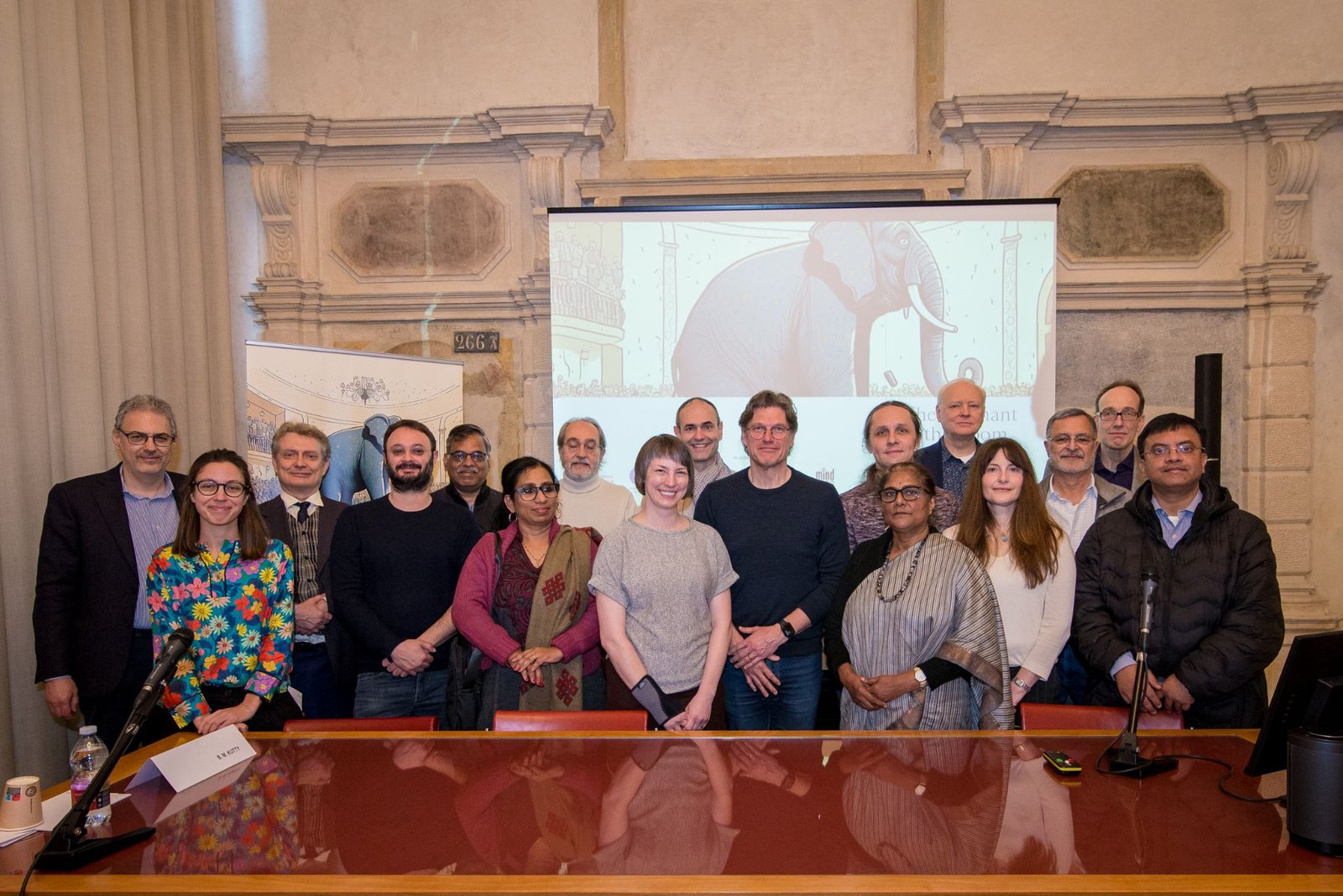
Roundtable Discussion with Mr Gladden Pappin
India Foundation hosted Mr Gladden Pappin, President of the Hungarian Institute of International Affairs, Budapest, Hungary, on 22 February, 2024, for a roundtable discussion on “Evolving Intra-EU Politics” in New Delhi.
7th Indian Ocean Conference – IOC 2024
The 7th Indian Ocean Conference – IOC 2024 was hosted by India Foundation in association with the Ministry of External Affairs of India ; Department of Foreign Affairs and Trade, Government of Australia; Perth USAsia Centre of Australia and S. Rajaratnam School of International Studies of Singapore on February 9-10, 2024 in Perth, Australia. The theme for this edition of the conference was “Towards a Stable and Sustainable Indian Ocean”.
Over a span of two days, the Conference was addressed by Ministers from 16 countries, including one Head of State, Officials from 16 countries and 6 multilateral organisations. The delegates from over 40 countries attended the Conference.
Day 1 – February 9, 2024

The 7th Indian Ocean Conference – IOC 2024 commenced with the Opening Address by Mr Tim Watts, Assistant Minister of Foreign Affairs, Australia. He expressed his gratitude to India Foundation and Perth USAsia Centre for being partners in organising this Conference. He spoke about the similarities that India and Australia hold with respect to their geographical locations and emphasised on strengthening the Indian Ocean region with respect to maintaining transparency; adhering to rules and regulations and maintaining meaningful lines of communication to deepen the strategic resilience of the countries in the region.
Pre-Conference Thematic Sessions
Panel 1: Climate Change and the Energy Transition

The first panel of the Pre-Conference Thematic Session was under the theme: “Climate Change and the Energy Transition”. Panel 1 was moderated by Kristin Tilley, Ambassador for Climate Change, Australia. The speakers of the panel included Anil Trigunayat, Former Ambassador, India; Phil Midland, President, IHS International LLC, USA; Tony Worby, CEO Flourishing Oceans, Minderoo Foundation, Australia; Abdulla Isa Al-Abbasi, Director, Energy and Environment Program, Studies and Research Directorate, Bahrain Center for Strategic, International and Energy Studies (DERASAT), Bahrain and Kate O’Shaughnessy, Research Director, Perth USAsia Centre, Australia. The panel discussed the issue of the role of Indian Ocean countries to address the challenges of climate change in the region.
Panel 2: Blue Economy

The second panel of the Pre-Conference Thematic Session was under the theme: “Blue Economy”. Panel 2 was moderated by Gordon Flake, CEO, Perth USAsia Centre, Australia. The speakers of the panel included Anil Wadhwa, Former Ambassador, India; Angela Williamson, Director, Blue Policy and Planning, Blue Economy Cooperative Research Centre, Australia; Marie-May Jeremie, CEO, Seychelles Conservation and Adaptation Trust, Seychelles; Timothy Walker, Maritime Project Leader and Senior Researcher, Institute for Security Studies, South Africa and Asha de Vos, Founder, Oceanswell, Sri Lanka. The panel discussed the participation of the Indian Ocean countries in ensuring their responsibility to nurture the blue economy in a sustainable manner.
Panel 3: Managing Global Commons

The third panel of the Pre-Conference Thematic Session was under the theme: “Managing Global Commons”. Panel 3 was moderated by Sujan Chinoy, Director General, Manohar Parrikar Institute for Defence Studies and Analyses, India. The speakers of the panel included Sinderpal Singh, Senior Fellow, RSIS, Singapore; Frederic Grare, Senior Researcher, National Security College, Australian National University, France; Jacqueline Espenilla, Director, The University of the Philippines’ Institute for Maritime Affairs and Law of the Sea, Philippines; Manmohan Parkash, Former Senior Advisor, Office of President, Asian Development Bank, India and Russell Reichelt, Australian Sherpa High Level Panel for a Sustainable Ocean Economy, Australia. The panel discussed the role of Indian Ocean countries to collaborate and work together to manage and share the resources in the Indian Ocean region.
Panel 4: Partnerships for a Resilient Region
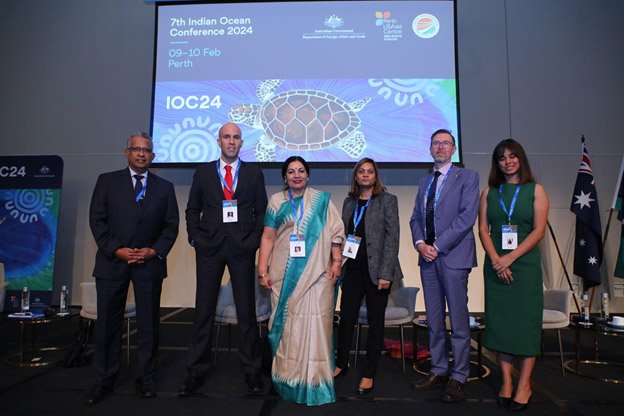
The fourth panel of the Pre-Conference Thematic Session was under the theme: “Partnerships for a Resilient Region”. Panel 4 was moderated by Sunaina Singh, Member, Board of Trustees, India Foundation, India. The speakers of the panel included David Santoro, President, Pacific Forum, USA; Rory Medcalf, Head of National Security College, Australian National University, Australia; Darshana Baruah, Fellow, Carnegie Endowment for International Peace, India; Roukaya Kasenally, Associate Professor, Media and Political Systems, University of Mauritius, Mauritius and Prasad Kariyawasam, Former Foreign Secretary, Sri Lanka. The panel discussed the role of the countries in the Indian Ocean region to collaborate for the region’s sustainable development and a resilient future for all.
Inaugural Session
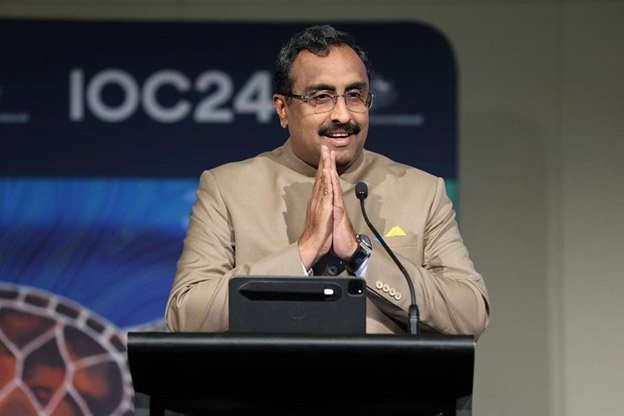
The Inaugural Session of the 7th Indian Ocean Conference commenced with the Curtain Raiser Address by Dr Ram Madhav, President, India Foundation. In his address, Dr Madhav spoke about the Indian Ocean not being “an artificial geo-political construct” but a natural region and home to around 40 nations and more of a “civilisation than a mere maritime geography”. He focused on the “non-traditional” challenges the countries of the Indian Ocean region face like climate change, natural disasters, ocean levels and supply chains over the traditional security issues that sustain all over the world and thus, the Indian Ocean Conference providing the platform to create a forum for deliberation on these challenges and to work out the measures to tackle them.
Dr Madhav expressed his gratitude to Senator Penny Wong, Minister of Foreign Affairs, Australia, for taking the initiative to host the 7th Indian Ocean Conference in Perth, Australia and for joining hands with the Indian Ocean region countries and outgrowing its “Pacific Ocean centric identity”. He also thanked H.E. Ranil Wickremesinghe, President, Sri Lanka; Dr S Jaishankar, External Affairs Minister, India; Dr Vivian Balakrishnan, Minister for Foreign Affairs, Singapore and Sayyid Badr Al-Busaidi, Foreign Minister, Oman for being associated with the series of Indian Ocean Conference since its inception.
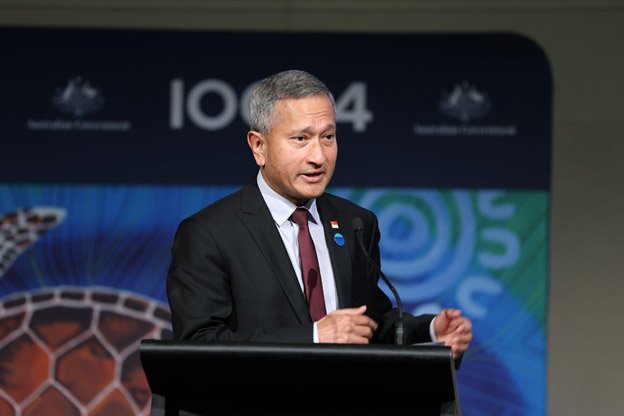
Dr Vivian Balakrishnan, Minister for Foreign Affairs, Singapore, delivered his remarks on the strategic and historical significance of the Indian Ocean, being the “conduit of culture, language, religion and trade”. He spoke about the “choke points” in the Indian Ocean, first of which lies with Singapore and its connectivity with the rest of the world through the Strait of Malacca; secondly, the strategic and economic significance of the Indian Ocean for trade and maritime shipping. Dr Balakrishnan also spoke about the benefits of freedom of navigation and the importance maritime shipping holds for Singapore. Speaking about dangers of coral bleaching, he raised concerns for the sustainable use of marine biodiversity. He also spoke for seeking partnerships for collaborations on “green shipping corridors” to contribute to develop standards, best practices and the technology for decarbonisation, digitalisation, and sustainable growth of the maritime industry.
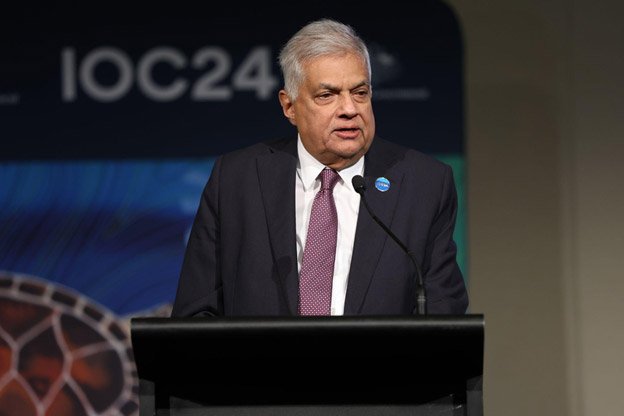
H.E Ranil Wickremesinghe, President, Sri Lanka, highlighted the importance and critical need of enhanced connectivity structure in the Indian Ocean region. He emphasised on the need for a collective geopolitical construct in the region to avoid “contested visions and multiple interpretations”. He also spoke about developments in the western Indian Ocean particularly due to geopolitical shifts and influence of major powers like Russia, China and Iran. The President also spoke of the present day challenges such as recent attacks on commercial vessels by Yemen-based Houthi rebels, and threats of piracy that tends to endanger the idea of freedom of navigation. He also emphasised on the issue of climate crisis, focusing on the Indian Ocean’s vulnerability due to Global Warming, and rising sea levels. He proposed for unity among Indian Ocean Rim countries to address shared challenges and look forward to collective actions and solutions for a more sustainable ocean environment.
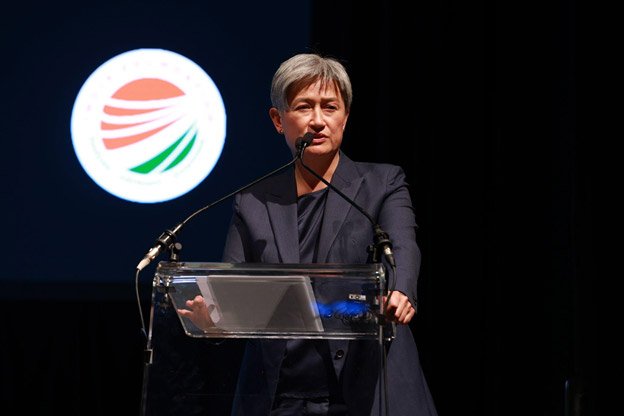
Ms Penny Wong, Minister for Foreign Affairs, Australia, delivered the first keynote address at of the evening. She mentioned Perth as the Indian Ocean capital and the relevance Australia holds in engaging with diverse communities from South and East Asia. She acknowledged the unprecedented threats that have been affecting the prosperity, peace and resilience of the Indian Ocean region leading to depravity of food and energy resources along with rising levels of tensions, conflicts and transnational crime and terrorism. She also raised concern towards ocean warming, acidification, and coral bleaching and called for preservation of the oceanic ecosystem by working collectively towards slowing down the destruction caused by climate change. The Minister also announced the launch of Marine and Coastal Resilience Hub under India’s Indo-Pacific Oceans Initiative. Ms Wong emphasised on building an Indian Ocean community and working towards collective cooperation and collaboration and embracing the regional diversity as strength in building partnerships among nations.
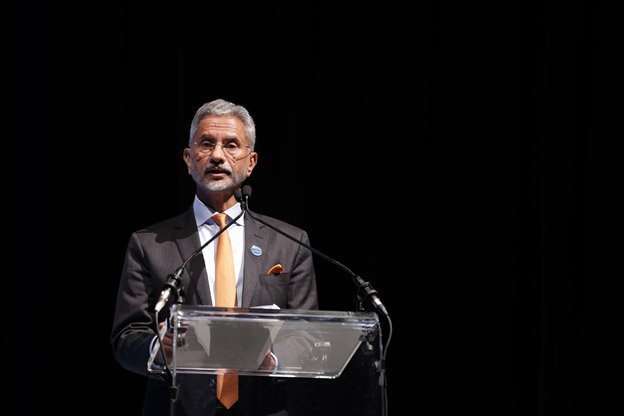
Dr S Jaishankar, External Affairs Minister, India, delivered the second keynote address of the 7th Indian Ocean Conference. He spoke about the issues of maritime traffic, piracy, terrorism and the challenges to international law along with concerns about freedom of navigation and safeguarding of sovereignty and independence of the countries in the Indian Ocean region. He raised concerns about the “grey areas” of various kinds that include climate change, natural disasters and the complexities of dual-purpose agendas that have created anxieties for the stakeholders. Dr Jaishankar emphasised upon the problems of the rise of inherent globalisation which has created supply-side risks and the possibilities of leveraging and thus the need to disperse production amongst more geographies and build “reliable and resilient supply-chains”. He spoke about the importance of the Indian Ocean Rim Association (IORA) and BIMSTEC in the region, the development and consolidation of the Quad grouping and emphasised the significance of India-Australia ties for the regional and global good.
Day 2 – February 10, 2024
Fireside Chat
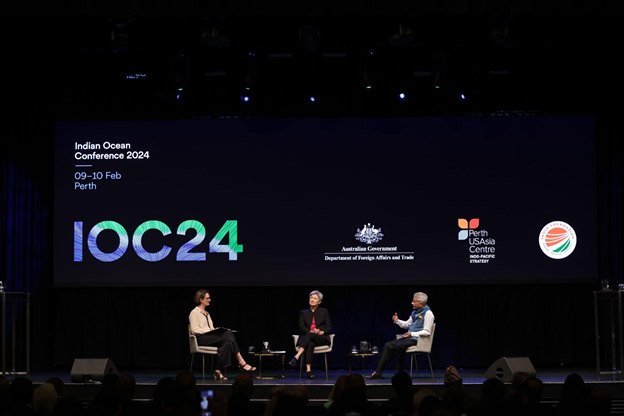
The second day of the Conference started with a fireside chat between Ms Penny Wong, Minister for Foreign Affairs, Australia and Dr S Jaishankar, External Affairs Minister, India. They spoke about the significance of India-Australia bilateral relations and their development in present times which is reflected in the betterment of the region and the complementary relationship the two countries share thus bringing two different perspectives towards a common ground. The ministers spoke about the equation both the countries have with other Indian Ocean countries and how it elevates the regional engagements. They also spoke about the development of regional architecture in the Indian Ocean and the role of Quad in subsequent developments.
Plenary Session 1
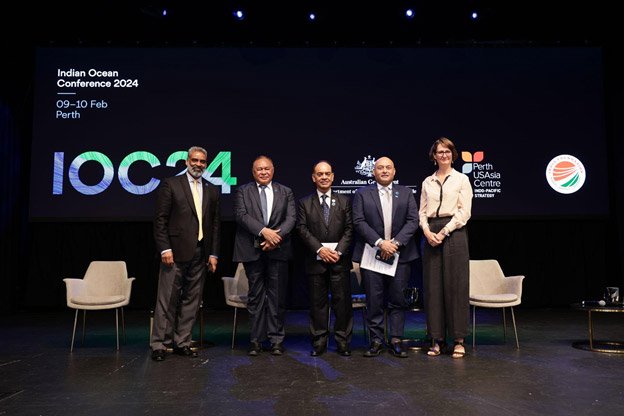
The first Plenary Session of Day 2 of the Conference was hosted by Kate O’Shaughnessy, Research Director, Perth USAsia Centre, Australia. The speakers of the panel included Maneesh GOBIN, Minister of Foreign Affairs, Regional Integration and International Trade, Mauritius; Bendito dos Santos Freitas, Minister of Foreign Affairs and Cooperation, Timor Leste; Muhammad Faruk Khan, Minister for Civil Aviation and Tourism, Bangladesh and Richard Verma, Deputy Secretary of State for Management & Resources, USA. The ministers spoke about the role of Indian Ocean countries to contribute and cooperate on their shared interests to secure a peaceful and prosperous region for the future generations.
Plenary Session 2
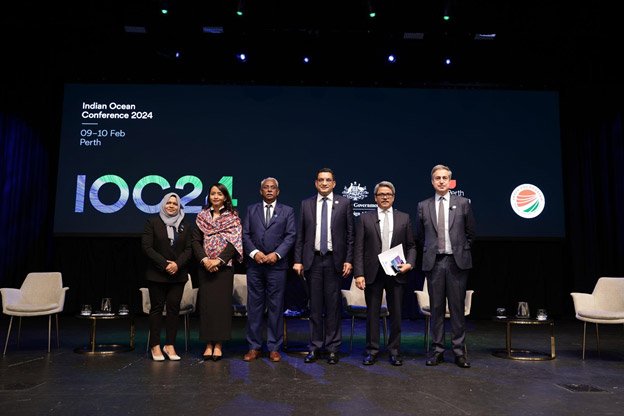
The second plenary session of the Conference was moderated by Md Shahriar Alam, Member of Parliament and Former Minister of State for Foreign Affairs, Bangladesh. The speakers of the panel were Rafaravavitafika Rasata, Minister of Foreign Affairs, Madagascar; M.U.M. Ali Sabry PC, MP, Minister of Foreign Affairs, Sri Lanka; Errol Fonseka, Minister of Internal Affairs, Seychelles; Sheryna Abdul Samad, Minister of State for Foreign Affairs, Maldives and Marc Abensour, Ambassador for the Indo-Pacific, France. The speakers of the session discussed various issues in the Indian Ocean region and the significance of the island states in the region to safeguard the well-being of the shared ocean resources.
Plenary Session 3
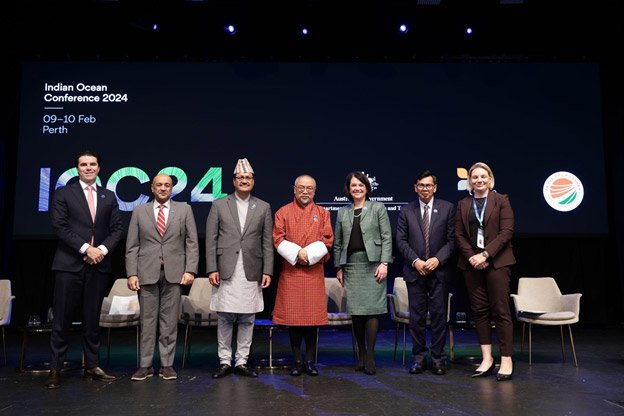
The third plenary session was chaired by Jennifer Parker, Expert Associate, National Security College, Australian National University. The speakers of the panel included Tim Watts, Assistant Foreign Minister, Australia; Jasem Mohamed AlBudaiwi, Secretary General, GCC; Narayan Prakash Saud, Minister for Foreign Affairs, Nepal; Dasho Chhewang Rinzin, Advisor, Ministry of Foreign Affairs and External Trade, Bhutan; Eileen Laubacher, Special Assistant to the President and Senior Director for South Asia, National Security Council (NSC), USA and Yayan Ganda Hayat Mulyana, Head, Indonesia’s Foreign Policy Strategy Agency, Indonesia. The panellists deliberated on the role of new technologies and innovations which could benefit the Indian Ocean region.
Plenary Session 4

The fourth plenary session was moderated by Arun Sahni, Member, Governing Council, India Foundation and Former GOC-in-C, South Western Command, India. The panellists of the session were Anne-Marie Trevelyan MP, Minister of State (Indo-Pacific), UK; Nguyen Minh Vu, Vice Minister of Foreign Affairs, Vietnam; Ahmed Ali Al Sayegh, Minister of State for Foreign Affairs, UAE; Golam Sarwar, Secretary General, SAARC; Busadee Santipitaks, Deputy Permanent Secretary, Thailand; Shaikh Abdulaziz Al Hinai, Ambassador at Large, Ministry of Foreign Affairs, Oman and Gabriele Visentin, Ambassador of EU to Australia, EU. The ministers and officials in the session discussed the collective prosperity, sustainability and connectivity in the Indian Ocean region and how the Indian Ocean countries can ensure a safe and secure future of the region.
Plenary Session 5
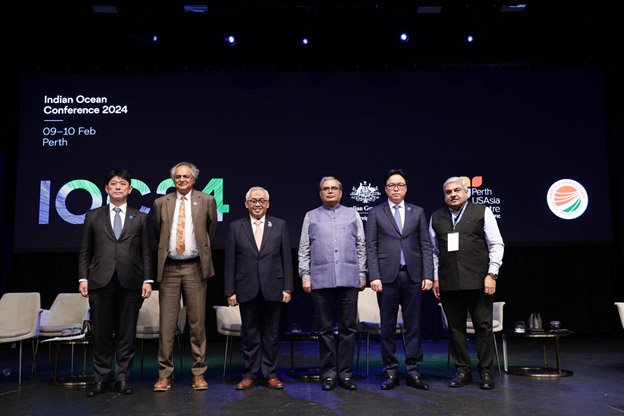
The fifth plenary session was chaired by Anil Wadhwa, Former Ambassador, India. The speakers of the session included Masahiro Komura, Parliamentary Vice Minister for Foreign Affairs, Japan; Velayoudom Marimoutou, Secretary General, Indian Ocean Commission; Salman Al Farisi, Secretary General, IORA; Indra Mani Pandey, Secretary General, BIMSTEC and Prak Nguon Hong, Secretary of State, Ministry of Foreign Affairs and International Cooperation, Cambodia. The speakers in the session spoke on facilitating collective action and cooperation, especially through regional architecture amongst the Indian Ocean countries.
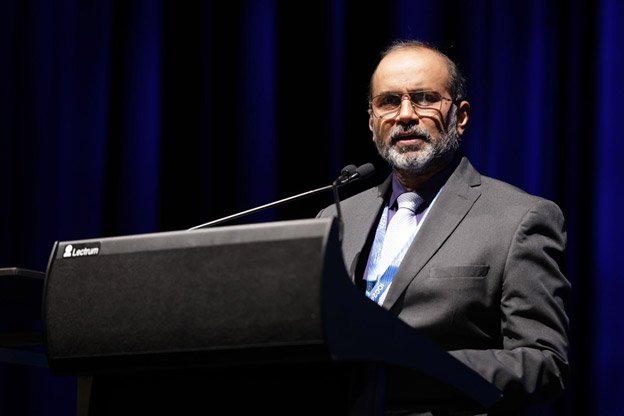
The 2-day 7th Indian Ocean Conference concluded with the Vote of Thanks by Capt Alok Bansal, Director, India Foundation.
Roundtable Discussion on ‘Bharatiya View of Conservatism’
Under the aegis of India Foundation, Conservatives’ Collective hosted a roundtable discussion on ‘Bharatiya View of Conservatism’ on February 04, 2024. The discussion witnessed significant contributions from senior scholars and academicians, along with important interventions from the participants, which included research scholars from various institutions and people from the academic communities in and around New Delhi.
At the outset of the discussion, Prof. Shri Prakash Singh, Director, South Campus, University of Delhi, and Convener, Conservatives’ Collective, introduced the initiative of the forum to the participants.
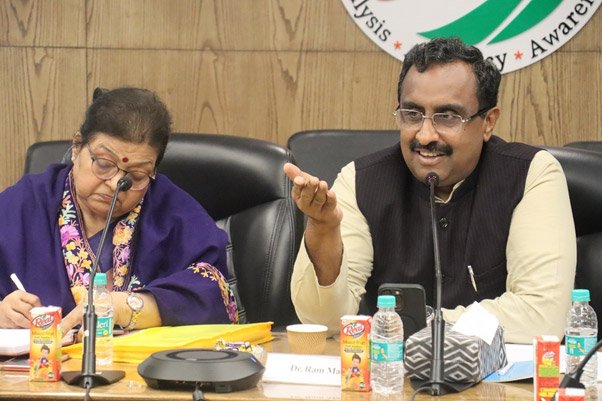
The initial remarks for the roundtable discussion were delivered by Dr. Ram Madhav, President, India Foundation, setting the tone and contours for the discussion. He shed light on the basic tenets of conservatism, as it emerged as a political philosophy in the West. As identified by him, some of the prominent tenets are individual freedom, limited government, rule of law, responsible fiscalism, commitment to human dignity, and acknowledging the centrality of family as a social institution. He further stated that while conservatism as a political idea may not be indigenous to the Indian context, the influence of international political discourses led to the categorization and tacit acceptance of such rubrics by Indian political thinkers and leaders as well. He also delved upon the need to engage with conservative thinkers of the Western world, and attempt to locate similar concerns and methods of addressal. The discussions were driven by the idea of articulation of Bharatiya political thought in a manner such that it is able to be in a constant dialogue with global conservative thought. He explained the objective of the discussion towards building a larger consensus on the meaning of conservatism, the Bharatiya view on it, and a strategic positioning of Bharatiya view of conservatism, in effective communication with the global stakeholders.
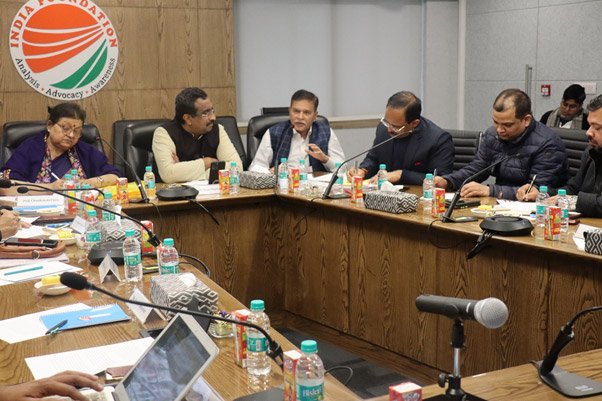
Dr. Madhav also chaired the first session of the roundtable discussion, which witnessed comprehensive deliberations on the subject by Prof. Chandrakala Padia, Former Vice Chancellor, Maharaja Ganga Singh University, and Prof. Rakesh Kumar Mishra, Former Head, Department of Political Science, University of Lucknow. Prof. Padia emphasized on the need to redefine ‘conservatism’ through an academic critique of the negative connotations associated with it, and by contextualizing it in the backdrop of Bharatiya worldview. She discussed the rich history of traditions, heritage, and culture that have anchored the Bharatiya civilization for several aeons, given a conservative disposition of our society towards such priced possessions. Prof. Mishra’s remarks were directed towards providing a conceptual clarity over the idea of conservatism and its Western origins. Tracing the idea back to thinkers such as Edmund Burke, he delved on the historical roots of conservatism, and its sharp differences from other ideologies such as socialism and liberalism. He also traced the presence of tropes of conservative disposition in Indian thinkers and political leaders such as Bal Gangadhara Tilak, C. Rajagopalachari, et. al.
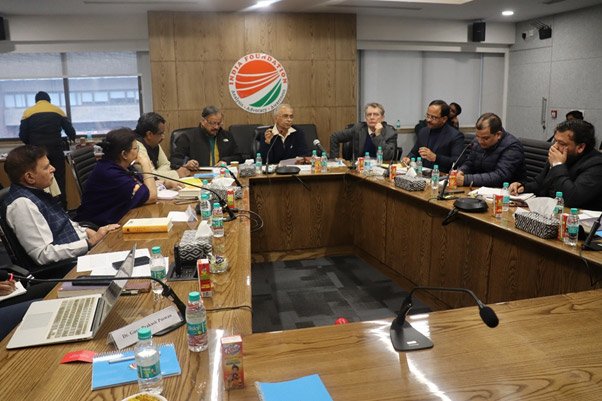
The second session was chaired by Prof. Shri Prakash Singh, Director, South Campus, University of Delhi, and Convener, Conservatives’ Collective. Dr. K. Aravinda Rao, IPS (Retd.) and a Vedic scholar, Prof. Soumendra Mohan Patnaik, Head, Department of Anthropology, University of Delhi, and Mr. Come Carpentier, Distinguished Fellow, India Foundation, delivered their remarks. Dr. Rao’s address was centered on the Bharatiya view of conservatism from the perspective of Upanishads. He explained the dialogic model of Upanishadic texts, and how they’re based on introspection and contemplation. Prof. Patnaik provided his insights on the theme from an anthropological perspective. He discussed the need for developing an outward looking discourse on conservatism which sheds light on the “little traditions”, localized and rooted in the Bharatiya worldview. Mr. Come Carpentier elaborated upon the basic tenets of conservatism, and the current state of conservative values and politics in the West.

The third session was chaired by Dr. Swadesh Singh, Assistant Professor, Satyawati College, University of Delhi. The session was addressed by Dr. Ravi Kant Mishra, Joint Director, Prime Ministers Museum and Library, Dr. Saumya Dey, Professor, Rishihood University, and Dr. Guru Prakash Paswan, Assistant Professor (Law), Patna University. Dr. Mishra delivered his remarks on Gandhi and religion, and reflected on some of the Gandhian values which find parallels with the conservative tradition. Dr. Dey highlighted the distinctiveness of Bharatiya conservatism, which seeks a fine balance between the universal and the particular in its quest for human solidarity. Dr. Guru Prakash elaborated on the socially inclusive and integrative nature of Bharatiya conservatism, and described its praxis through various significant events such as the Ram Mandir inauguration. He also discussed the inclusive role of Dalits in practicing the conservation of Bharatiya traditions.
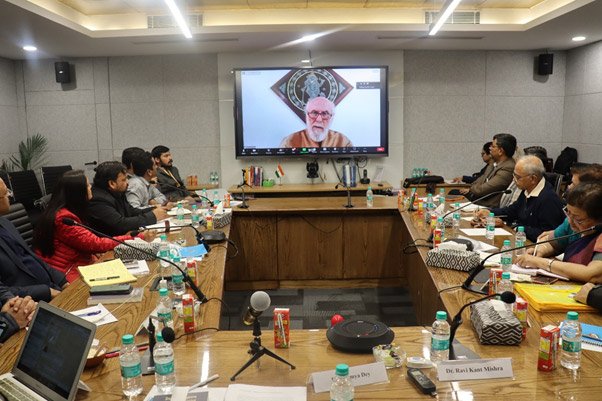
The special address was delivered by Dr. David Frawley, Founder and Director, American Institute of Vedic Studies. He delineated the unique aspects of Bharatiya conservatism, contrasting it with Western conservatism and shedding light on its potential impact globally. He highlighted that Bharatiya conservatism differs significantly from its Western counterpart. Rooted in the preservation and revival of a Dharmic civilization, it goes beyond religious, military, and political foundations. The Bharatiya tradition, encompassing a rich cultural, historical, and global heritage, is viewed as a progressive force that transcends traditional Western conservative values.
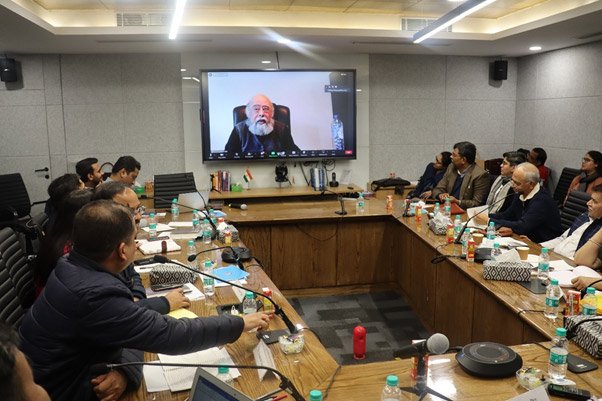
The concluding remarks were delivered by Prof. S. N. Balagangadhara, Professor Emeritus, University of Ghent. He distinguished Bharatiya view of conservatism from its Western counterpart, and explained how the Western conservative attitude made attempts to conserve abstract truth, while the Bharatiya traditions contemplated the conservation of knowledge. His insights into the distinctiveness of Bharatiya values and the potential for a dynamic conservatism that addresses contemporary challenges while preserving traditional principles contributed significantly to the roundtable discussion. The nuanced perspective enriched the dialogue and provided valuable insights for the future exploration of conservatism in the context of Bharat.

